Vol. 69, No. 7 (2020)
2020-04-05
SPECIAL TOPIC—The frontiers and applications of topological physics
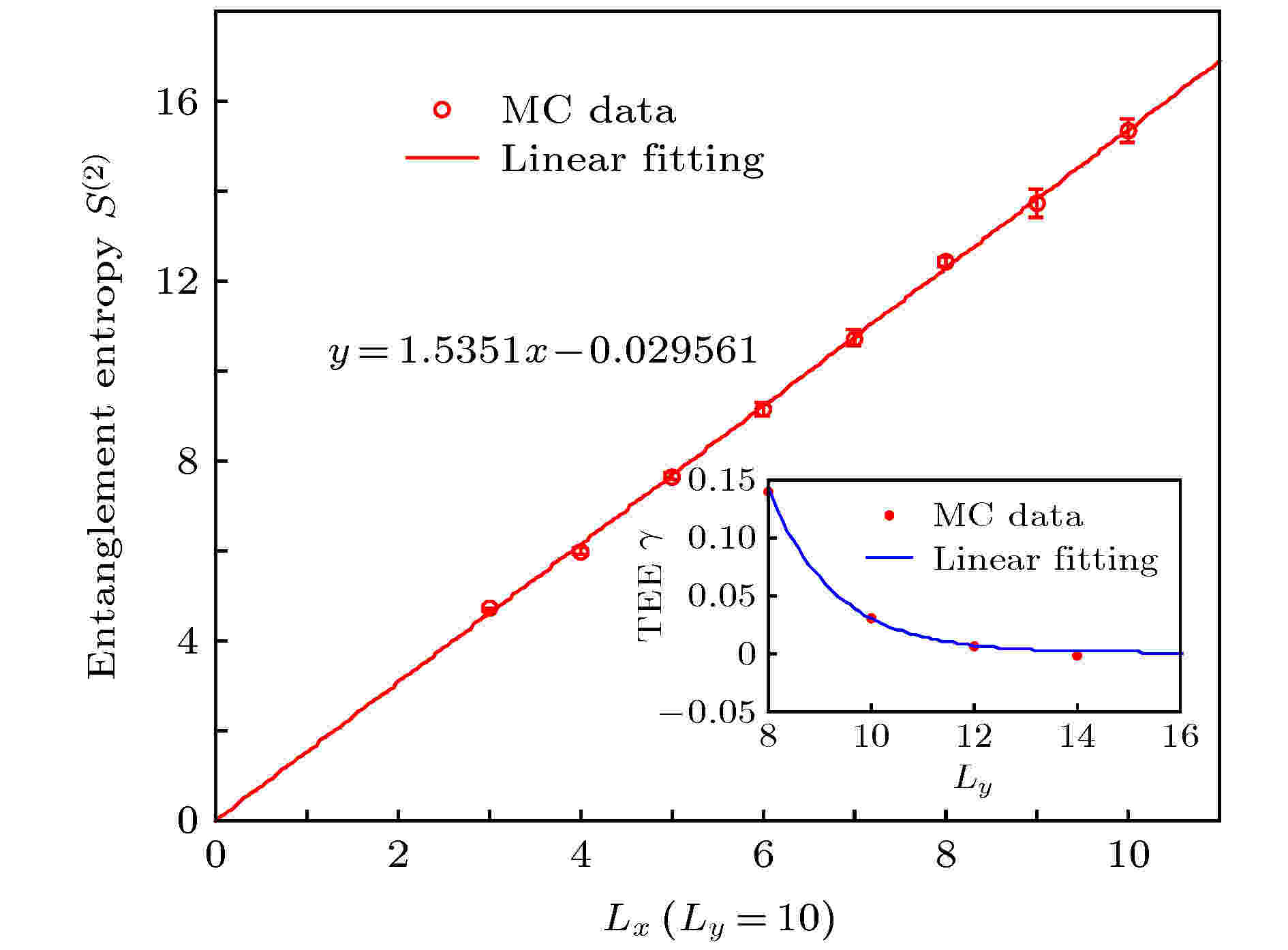
EDITOR'S SUGGESTION
2020, 69 (7): 077102.
doi: 10.7498/aps.69.20200197
Abstract +
In the presence of symmetry-protection, topological invariants of topological phases of matter in free fermion systems, e.g., topological band insulators, can be directly computed via the properties of band structure. Nevertheless, it is usually difficult to extract topological invariants in strongly-correlated topological phases of matter in which band structure is not well-defined. One typical example is the fractional quantum Hall effect whose low-energy physics is governed by Chern-Simons topological gauge theory and Hall conductivity plateaus involve extremely fruitful physics of strong correlation. In this article, we focus on intrinsic topological order (iTO), symmetry-protected topological phases (SPT), and symmetry-enriched topological phases (SET) in boson and spin systems. Through gauge field-theoretical approach, we review some research progress on these topological phases of matter from the aspects of projective construction, low-energy effective theory and topological response theory.
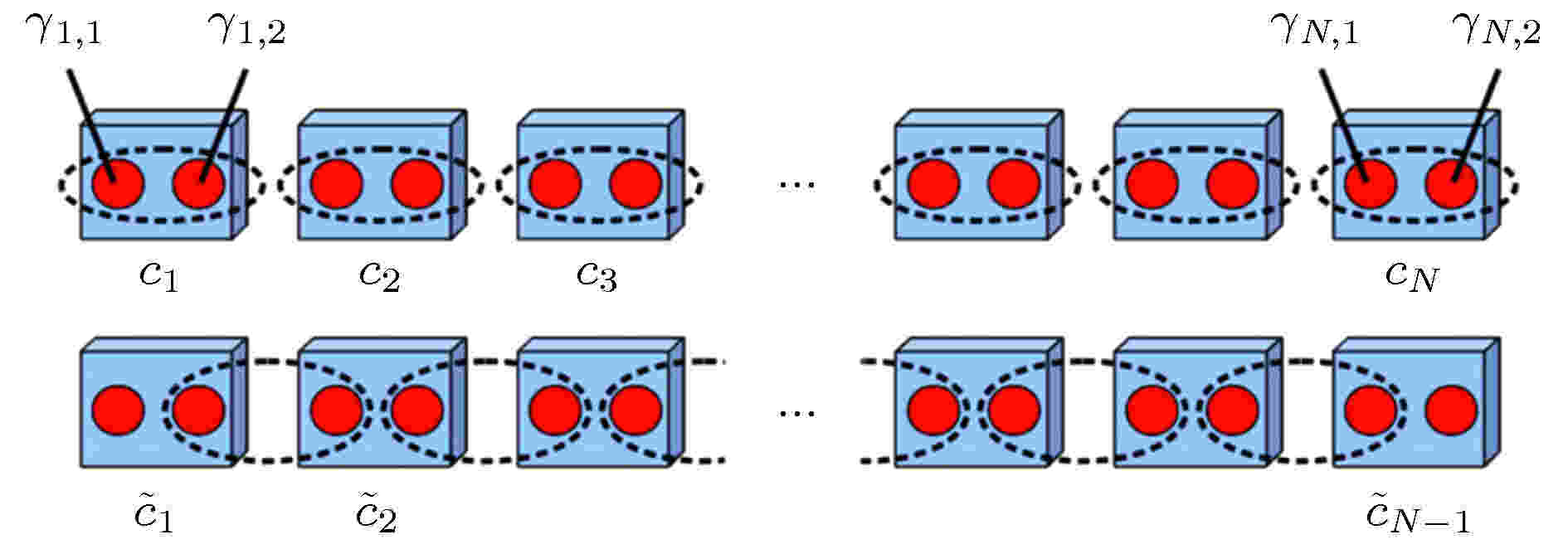
EDITOR'S SUGGESTION
2020, 69 (7): 077303.
doi: 10.7498/aps.69.20200177
Abstract +
Majorana fermions are known for being their own anti-particles. As the condensed matter version of Majorana fermions, Majorana quasiparticles have drawn extensive interests for being an ideal candidate for building a fault-tolerant quantum computer, due to their non-abelian statistics. This paper provides an introduction for beginners to the rapidly growing research field of Majorana quasiparticles focusing on one dimensional semiconductor nanowire-superconductor hybrid system. We aim to help readers to quickly understand Majorana quasiparticles and its formation mechanism and the latest experimental results. We first review the theoretical model of the Majorana quasiparticles with its historical background. We then discuss the Kitaev chain and analyze its key elements. We also introduce typical Majorana devices and their corresponding measurement methods. Furthermore, we discuss the observation of robust signatures of Majorana zero modes in recent experiments, with particular attention to tunneling conductance measurements. Finally, we give prospects on future experiments for advancing one dimensional semiconductor nanowire-superconductor hybrid system.
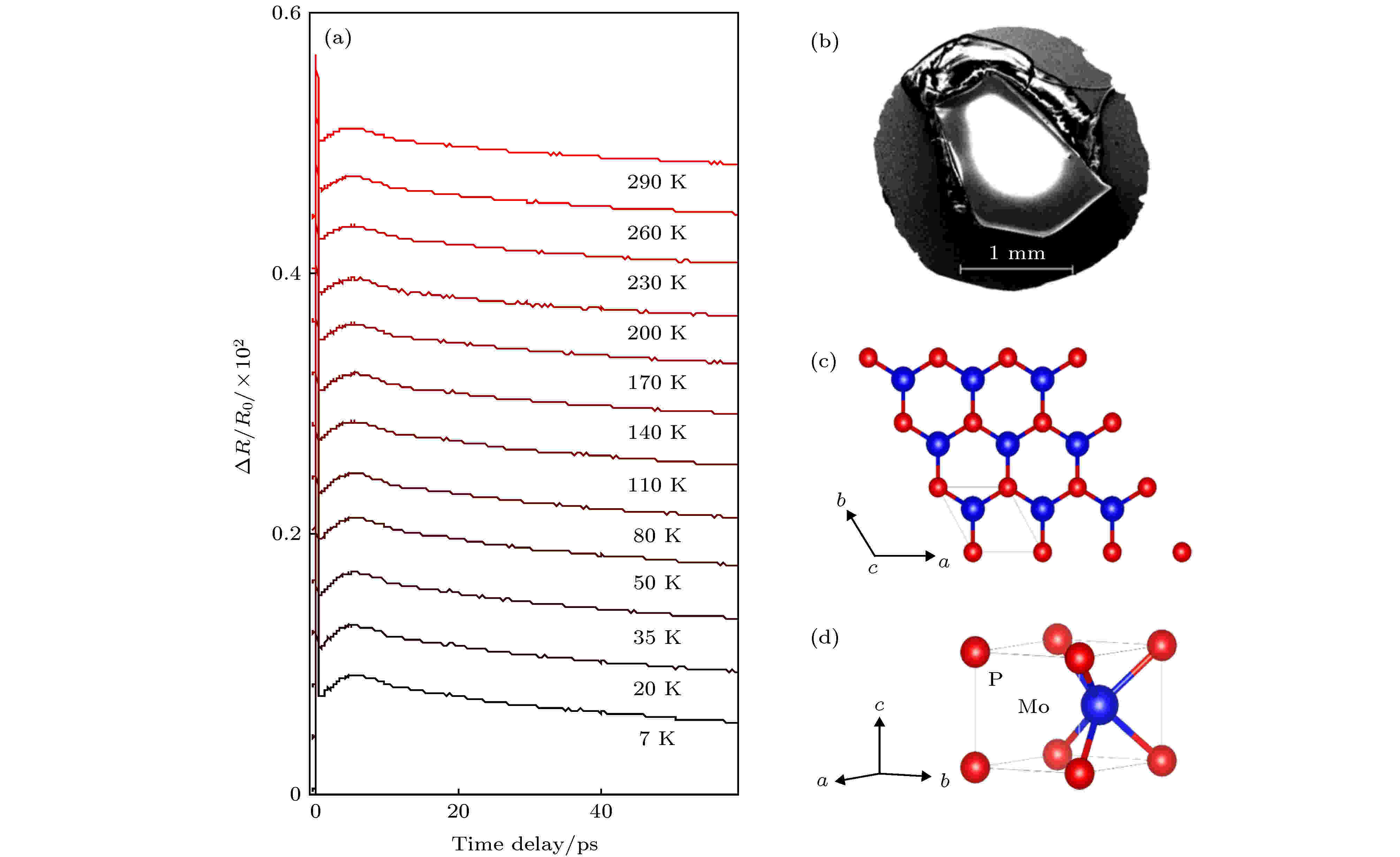
EDITOR'S SUGGESTION
2020, 69 (7): 077801.
doi: 10.7498/aps.69.20191816
Abstract +
We employ the time resolved pump probe experiment to investigate the ultrafast dynamics in a topological semimetal molybdenum phosphide (MoP), which exhibits triple degenerate points in the momentum space. Two relaxation processes with the lifetime of 0.3 and 150 ps have been observed. We attribute the fast component to the electron-phonon scattering and the slow component to the phonon-phonon scattering, respectively. Temperature dependence investigation shows that both the lifetimes of the fast and slow components enhance slightly with increasing temperature. We also successfully generate and detect a thermal-stress-induced coherent acoustic phonon mode with a frequency of 0.033 THz, which does not vary with temperature. Our ultrafast spectroscopy investigation of the quasiparticle dynamics and the coherent phonon in MoP provides useful experimental facts and information about the overall excited state dynamics and the temperature dependence of electron-phonon coupling.
REVIEW

2020, 69 (7): 077101.
doi: 10.7498/aps.69.20191660
Abstract +
In recent years, nano-structures used as light harvesting have been widely used in perovskite cells to enhance the photon absorption of cells. The introduction of trapping structures in perovskite cells can change the photon propagation in the cell and the photon energy absorbed by the cell. The nano-structure used in different interfaces of perovskite cells can increase the absorption of light by the device to different degrees, and ultimately improve the efficiency of the solar cell. Therefore, the effective light trapping structure has become trending in the application of perovskite cells. How to effectively apply the such nano-structure is the key to improve the power conversion efficiency(PCE) of perovskite cells. So far, there is three ways including surface antireflection nanostructure, texture structure and plasmon nanostructure to apply to perovskite solar cell. The first one is ordered and disordered antireflection nanostructure that enhance the absorption of light on the surface of perovskite cells and makes visible light scatter at the interface of the nanostructure to reflection probability, the second one is texture structure that can not only improve the light absorption but avoid the formation of short-circuit channel inside the cell, the third one is plasmon nanostructure that can further improve the absorption of the thin film absorption material in the long band, so as to achieve the effect of improving the light utilization and cell efficiency. The trap structure is expected to achieve good photon absorption performance in wide spectral range and wide incidence angle range under the condition of reducing the thickness of active layer. At the same time, it has the advantages of good repeatability, easy to simulate and easy to change the structure. Therefore, using various trap technologies to design efficient trap structure has become a research hotspot in the field of solar cells. So far, most of the reports on the trapping structure have been applied to the silicon-based thin film solar cells, but few of them have been reported on the perovskite cells. This paper starts from the description of the perovskite cell with different nano-structures, comparing and summarizing the different structures, and analyzes the advantages and Disadvantage.
GENERAL

2020, 69 (7): 070201.
doi: 10.7498/aps.69.20191591
Abstract +
Supercritical fluids (SCF) have been widely utilized in the industrial processes, such as extraction, cleaning, drying, foaming and power generation driven by primary energy. Therefore, SCF have attracted more and more attention in recent years. At supercritical state, liquid, and gas phase are not clearly distinguished, but the thermal-physical properties of fluid show an interesting characteristic, especially near the pseudo-critical temperature. Thus, it is of great significant to study the structure and density time series evolution of SCF.Due to high pressure and temperature for SCF, it can be challenging to collect experimental data of SCF. However, the advantage of molecular dynamics simulation in convenience, safty and cost over experiments. Therefore, in this paper,molecular dynamics simulation was performed to investigate the fluid structure and density series fluctuation curves at supercritical state, and the influence of parameters varitation including pressure and temperature onstructural characteristics was analyzed. In the simulation system, more than 104 atoms and simple Lennard-Jones(LJ) supercritical fluids were contained. The radial distribution function(RDF), coordination number(CN), density time series curve and permutation entropy of fluids at different pressures and temperatures were calculated. At specified pressure, the position of the first peak value of RDF gradually moves to the right with the increase of temperature, and the trend weakens with the increase of pressure. CN shows a downward trend with the increase of pressure and the CN difference at different temperatures gradually decreases. Simultaneously, the CN distribution area becomes narrow with the increase of pressure. The high/low density region calibrated by CN is stable, concentrated and large area distribution at low pressure, and the average density region is small, with the increase of pressure, the area of high/low density region is only a size of a few molecular and fluctuates sharply with time, and the area of average region is constantly expanding. At relatively low pressure, the density time series curve shows the characteristic that both the fluctuation range and quasi-period are large at pseudo-critical temperature. Simultaneously, the permutation entropy obtained from the time series curve shows three cases: (i) at low pressure (P = 1.1Pc), the minimum permutation entropy is obtained under the temperature that is lower than pseudo-critical temperature, and the system has higher orderliness; (ii) at moderate pressure (P = 1.3Pc and 1.5Pc), the state points corresponding to minimum permutation entropy is consistent with that corresponding to the maximum of isothermal compression coefficient and (iii) at high pressure (P = 2.0Pc), the permutation entropy curve fluctuates slightly and remains basically on the horizontal line. The results provide reliable support for revealing the characteristics of SCF from the microscale, and also provide useful inspiration for the practical application of SCF.

2020, 69 (7): 070301.
doi: 10.7498/aps.69.20191084
Abstract +
Complementarity, or more specifically, the wave-particle duality, and quantum coherence are two fundamental concepts in quantum mechanics. Recently, motivated by the progress of the quantification of quantum coherence, the complementary relation between coherence and path information is investigated by many authors, and various duality relations between them are established. Such relations not only provide insights into fundamental problems of quantum mechanics, such as the understanding of quantum coherence and wave-particle duality; but also are important in applications of quantum technologies. In this paper, based on the Bures distance and unambiguous quantum state discrimination, systematic analysis of the complementarity between the quantum coherence and path information in two path interferometers is carried out. Similarly as other related works, the wave aspect, or the visibility of the interferometer, is quantified by the l1-norm measure of quantum coherence, and the path information is considered via unambiguous quantum state discrimination. In this way, a novel duality relation in two path interferometers is obtained. Compared with known results, our work considers mixed states as well as pure states; considers the path predictability resulting from the intrinsic path asymmetry of the quantum state, as well as the path distinguishability resulting from the use of a which-path detector. Therefore, our work systematically generalizes known results in two path interferometers by removing all the unnecessary restrictions. Specifically, the most general form of quantum states in two path interferometers is considered and the duality relation between quantum coherence and path information is proved based on the positivity property of density matrices. The cases of path predictability and path distinguishability are considered separately. For path predictability, the proof is straightforward; whereas some advanced mathematical techniques, such as the Schur-Weyl inequality, properties of the fidelity and properties of positive matrices, are required in order to give a rigorous proof of the duality relation between coherence and path distinguishability. Concrete examples are provided to illustrate the abstract method and results. Our work concerns about two path interferometers exclusively and depends heavily that the dimensionality is two, therefore it would be an interesting task to generalize the results in this paper to n-path interferometers.
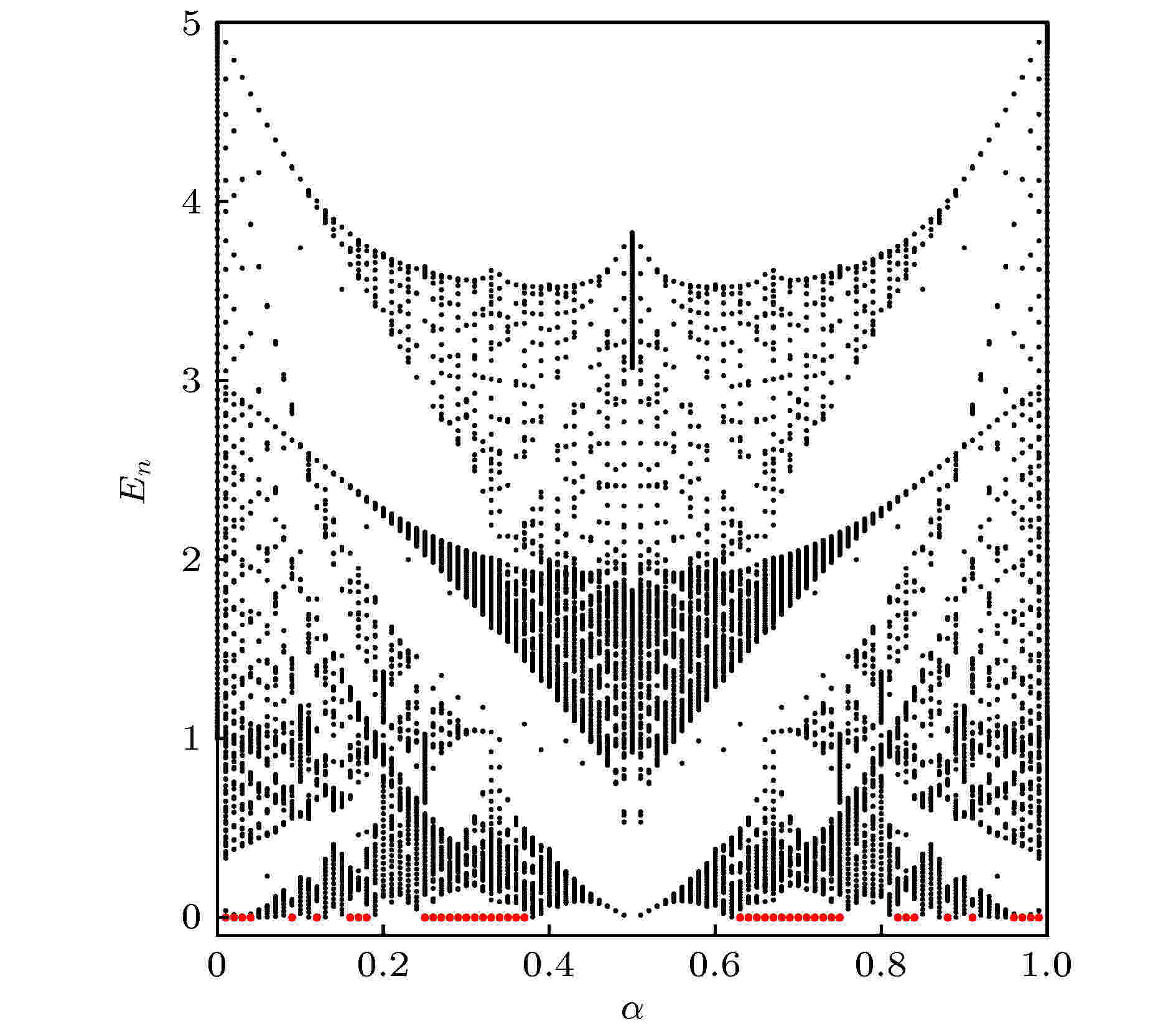
EDITOR'S SUGGESTION
2020, 69 (7): 070302.
doi: 10.7498/aps.69.20191868
Abstract +
We consider a one-dimensional p-wave superconducting quantum wire with the modulated chemical potential, which is described by $\hat{H}= \displaystyle\sum\nolimits_{i}\left[ \left( -t\hat{c}_{i}^{\dagger }\hat{c}_{i+1}+\Delta \hat{c}_{i}\hat{c}_{i+1}+ h.c.\right) +V_{i}\hat{n}_{i}\right]$ , $V_{i}=V\dfrac{\cos \left( 2{\text{π}} i\alpha + \delta \right) }{1-b\cos \left( 2{\text{π}} i\alpha+\delta \right) }$ and can be solved by the Bogoliubov-de Gennes method. When $b=0$ , $\alpha$ is a rational number, the system undergoes a transition from topologically nontrivial phase to topologically trivial phase which is accompanied by the disappearance of the Majorana fermions and the changing of the $Z_2$ topological invariant of the bulk system. We find the phase transition strongly depends on the strength of potential V and the phase shift $\delta$ . For some certain special parameters $\alpha$ and $\delta$ , the critical strength of the phase transition is infinity. For the incommensurate case, i.e. $\alpha=(\sqrt{5}-1)/2$ , the phase diagram is identified by analyzing the low-energy spectrum, the amplitudes of the lowest excitation states, the $Z_2$ topological invariant and the inverse participation ratio (IPR) which characterizes the localization of the wave functions. Three phases emerge in such case for $\delta=0$ , topologically nontrivial superconductor, topologically trivial superconductor and topologically trivial Anderson insulator. For a topologically nontrivial superconductor, it displays zero-energy Majorana fermions with a $Z_2$ topological invariant. By calculating the IPR, we find the lowest excitation states of the topologically trivial superconductor and topologically trivial Anderson insulator show different scaling features. For a topologically trivial superconductor, the IPR of the lowest excitation state tends to zero with the increase of the size, while it keeps a finite value for different sizes in the trivial Anderson localization phase.

2020, 69 (7): 070501.
doi: 10.7498/aps.69.20191812
Abstract +
Relaxation oscillations are ubiquitous in various fields of natural science and engineering technology. Exploring possible routes to relaxation oscillations is one of the important issues in the study of relaxation oscillations. Recently, the pulse-shaped explosion (PSE), a novel mechanism which can lead to relaxation oscillations, has been reported. The PSE means pulse-shaped sharp quantitative changes related the variation of system parameters in branches of equilibrium points and limit cycles, which leads the system’s trajectory to undertake sharp transitions and further induces relaxation oscillations. Regarding externally and parametrically excited nonlinear systems with different frequency ratios, some work on PSE has been reported. The present paper focuses on the PSE and the related relaxation oscillations in a externally and parametrically excited Mathieu-van der Pol-Duffing system. We show that if there is an initial phase difference between the slow excitations with the same frequency ratio, the fast subsystem may compose of two parts with different expressions, each of which determines a different vector field. As a result, the bistable behaviors are observed in the system. In particular, one of the vector fields exhibits two groups of bifurcation behaviors, which are symmetric with respect to the positive and negative PSE, and each can induce a cluster in the relaxation oscillations. Based on this, we present several routes to compound relaxation oscillations, and obtain new types of relaxation oscillations connected by pulse-shaped explosion, which we call compound “subHopf/fold-cycle” relaxation oscillations and compound “supHopf/supHopf” relaxation oscillations, respectively. Our results show that the two clusters in the resultant relaxation oscillations are connected by the PSE, and the initial phase difference plays an important role in transitions to different attractors and the generation of relaxation oscillations. Although the research in this paper is based on a specific nonlinear system, we would like to point out that the bistable behaviors, the PSE and the resultant compound relaxation oscillations can also be observed in other dynamical systems. The reason is that the fast subsystem composes of two different vector fields induced by the initial phase difference, which dose not rely on a specific system. The results of this paper deepen the research about PSE as well as the complex dynamics of relaxation oscillations.
ATOMIC AND MOLECULAR PHYSICS

2020, 69 (7): 073201.
doi: 10.7498/aps.69.20200013
Abstract +
Since imaging the geometrical structure of molecules can help to understand the microscopic world intuitively, and thereby to promote the development of physics, chemistry, material science and biological science, it has long been an important subject for scientists to probe the molecular internal structure. Generally, however, because of the relative complexity of the molecular internal structure, it is difficult to obtain the relevant information by ordinary experimental means. With the development of laser technology, especially the advent of intense ultrafast laser field, ultrafast laser pulse provides an unprecedented detection tool to investigate the related ultrafast dynamics. In recent years, strong field high-order nonlinear ultrafast processes, such as above-threshold ionization(ATI), high-order above-threshold ionization(HATI), high harmonic generation(HHG), and non-sequential double ionization (NSDI), were produced by using femtosecond ultrafast laser to excite molecules. Since the molecules excited in these processes emit the photon and electron signals pertinent to their internal structures, it is natural that one can obtain the imaging of molecular structure by extracting the signals. Recently, we have demonstrated that the structural information of SF6 molecules can be obtained by the interference fringes on the ATI spectrum using the infrared and ultraviolet bichromatic laser fields[arXiv, 1912.08499 (2019)]. In this paper, we use frequency-domian method, which is based on non-perturbed quantum electrodynamics, to investigate the direct above-threshold ionization (ATI) process of triatomic molecular ion $ \rm H_3^{2+} $ with two different geometrical structures by monochromatic and bichromatic laser fields, and given the detailed analysis of the spectra for each case. Compared with the monochromatic laser field, it is found that the ATI spectrum by the bichromatic laser field is more sensitive to the geometrical configuration of molecular ion, thereby it can be applied to identify the different geometrical structure of molecules. In the case of bichromatic laser fields, the direct ATI spectrum show different interference fringes with different molecular configurations. We give the beginning and cutoff curves of each platform by employing the saddle-point approximation. Furthermore, we derive the destructive curves formulas for different molecular configurations in angle-resolved direct ATI energy spectra and momentum spectra, respectively, which carries the information about themolecular structure. In addition, it is found that the shape of the spectra can be modified by changing the molecular internuclear distance or varying the laser intensity. Thereby, it can be inferred that the ATI spectrum induced by bichromatic laser field has the ability to identify different configurations of the same molecules, which is instructive to image geometrical structure of complex molecules.
ELECTROMAGNETISM, OPTICS, ACOUSTICS, HEAT TRANSFER, CLASSICAL MECHANICS, AND FLUID DYNAMICS
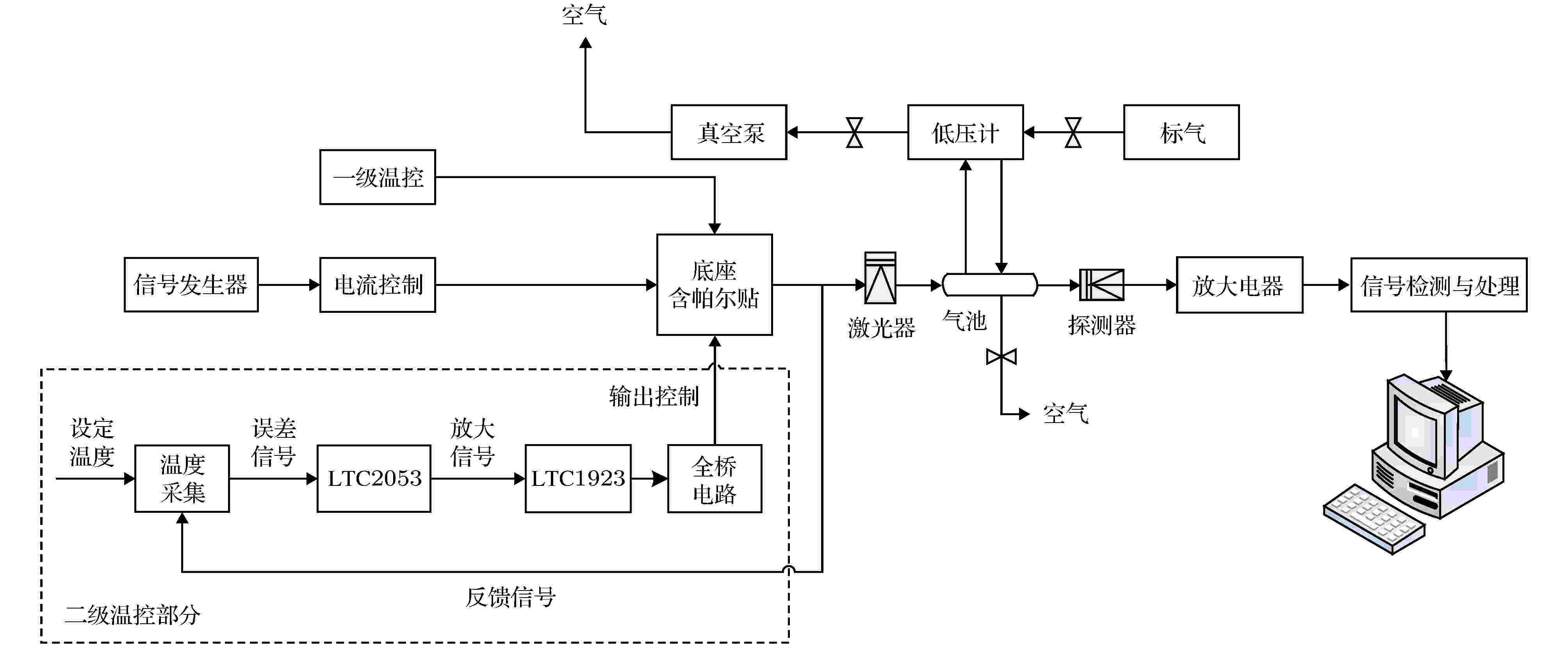
2020, 69 (7): 074201.
doi: 10.7498/aps.69.20191832
Abstract +
Due to the important role of NH3 in atmospheric aerosol chemistry, rapid and accurate inversion of ammonia concentration is very important for environmental issues. In this paper, a 9.05 μm continuous quantum cascade laser (QCL) is used as the light source at room temperature, and the scanned-wavelength direct-absorption tunable diode laser absorption spectroscopy (TDLAS) is used to study the spectral characteristics of the QCL at 1103.4 cm–1. A low-pressure experimental platform based on two-level temperature control was designed to measure the six aliasing absorption lines of ammonia at 1103.4 cm–1. The broadening of spectral line becomes smaller under the condition of reducing the pressure, and the aliasing spectra are separated. The line strength of each absorption line is calculated, and the measurement uncertainty is further analyzed. A method for accurate inversion of single-spectrum gas concentration by low-pressure separation was proposed for severely aliased spectra, and experimental verification was performed. By comparing the results with the HITRAN database, it is concluded that the experimental measured line strength of ammonia gas at 1103.4 cm–1 has a deviation from the database of . The uncertainty of the line intensity measurement is mainly related to the separation and extraction of aliasing absorbance, which is about 2.42%–8.92%. The deviation between the inversion concentration and the actual value under the condition of extreme low pressure is between 1% and 3%, while the calculated deviation of the line intensity value in the 2.71%–4.71% HITRAN database is about 3% to 5%. The results above indicate that the experimental data are reliable. The non-separative aliasing spectral line method is used to invert the concentration at normal pressure, and the low-pressure separated single spectral line method is used to invert the concentration at low pressure. The results of the two are compared. The analysis results show that the low-pressure separation single-spectrum spectral line inversion concentration value has smaller deviation and higher accuracy from the original concentration. The study of this method provides reference for future inversion of gas concentrations inversion in the atmospheric environment and other fields.

2020, 69 (7): 074202.
doi: 10.7498/aps.69.20191858
Abstract +
In recent years, the demand for network bandwidth has increased significantly, and the capacity of wave division multiplexing (WDM) systems has reached the nonlinear Shannon limit. In order to adapt to the development of future networks, space division multiplexing (SDM) technology attracts more and more attention. In this paper, we put forward a novel structure of pulse amplitude modulation(PAM) regenerator based on few-mode nonlinear optical fiber loop mirror (FM-NOLM) for the first time, and theoretically analyze the working principle for few-mode reshaping. It can regenerate degraded PAM signals and improve transmission performance in SDM system. The detailed design steps of the regenerator are given, in which the sulfide highly nonlinear fiber and multimode coupler are used to build up the FM-NOLM and their mode characteristics are simulated by COMSOL software. The parameters of the regenerator are determined by taking the few-mode optical fiber supporting LP01, LP11, and LP21 modes as an example, and then the power transfer function (PTF) curve of each mode for PAM signals is calculated. We simulate and analyze the noise reduction ratio (NRR) performance of the few-mode regenerator for PAM-4 signals, and compare with the case of single mode fiber. Our simulation shows that: (1) for each spatial mode of PAM signal, all regenerative levels have the same consistent power transfer performance; (2) for the input signal-to-noise ratio (SNR) greater than 20 dB, the NRR for each mode can exceed 3 dB, and increase with the input SNR at the slope of about 1.2; (3) the NRR difference between the three modes is less than 1.1 dB for the same input SNR. In order to illustrate the reshaping function of the regenerator, we also present the power distribution histograms for PAM-4 signals before and after regeneration when the input SNR is 25 dB. This scheme proposed here has some advantages over the existing regenerators in the applicability for the long-haul SDM system with high spectral efficiency and regeneration of any level number of PAM signals in theory due to its uniform multi-level regeneration function, but also is capable of being extended to the wavelength domain for higher transmission capacity.
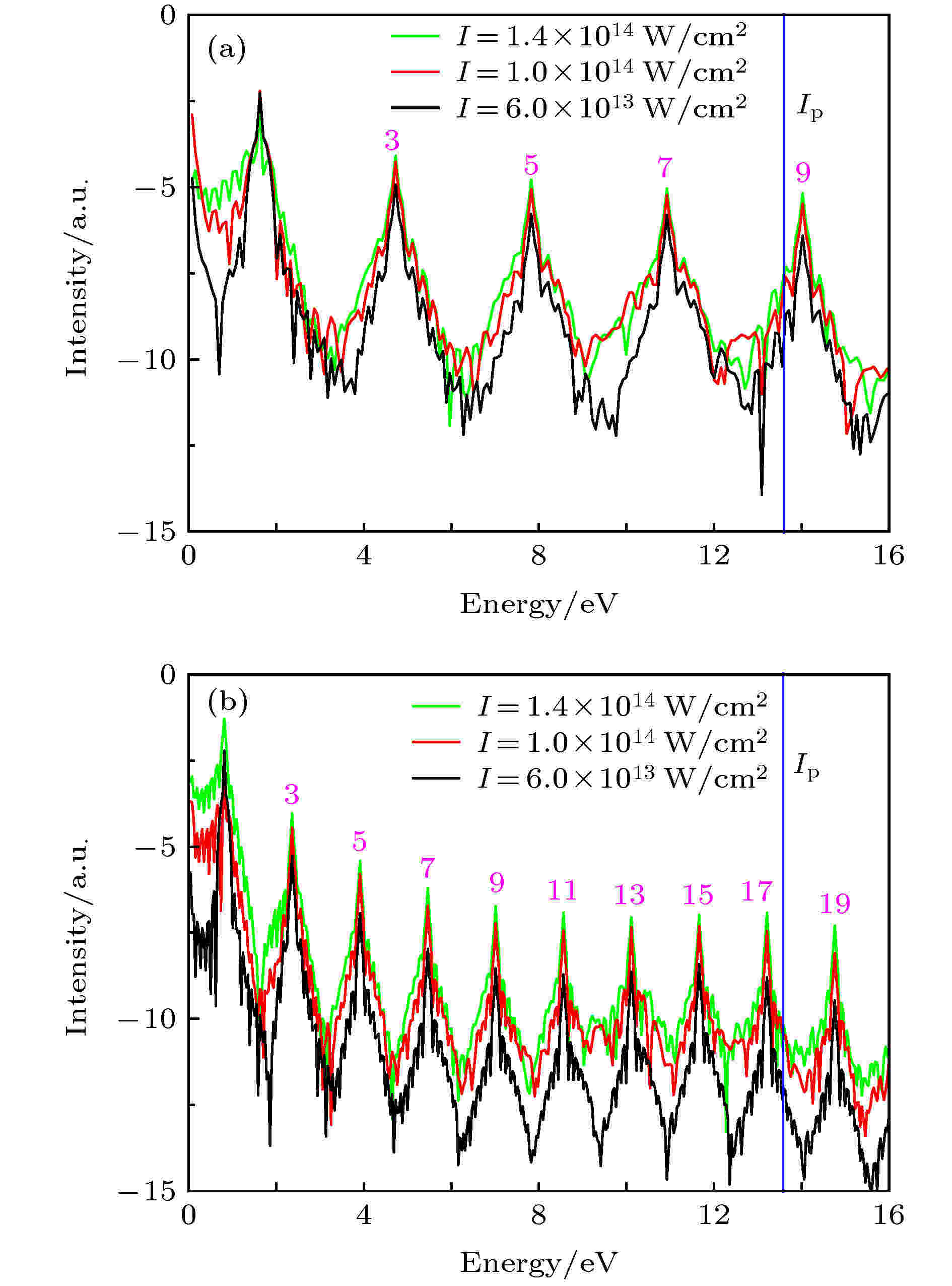
2020, 69 (7): 074203.
doi: 10.7498/aps.69.20191883
Abstract +
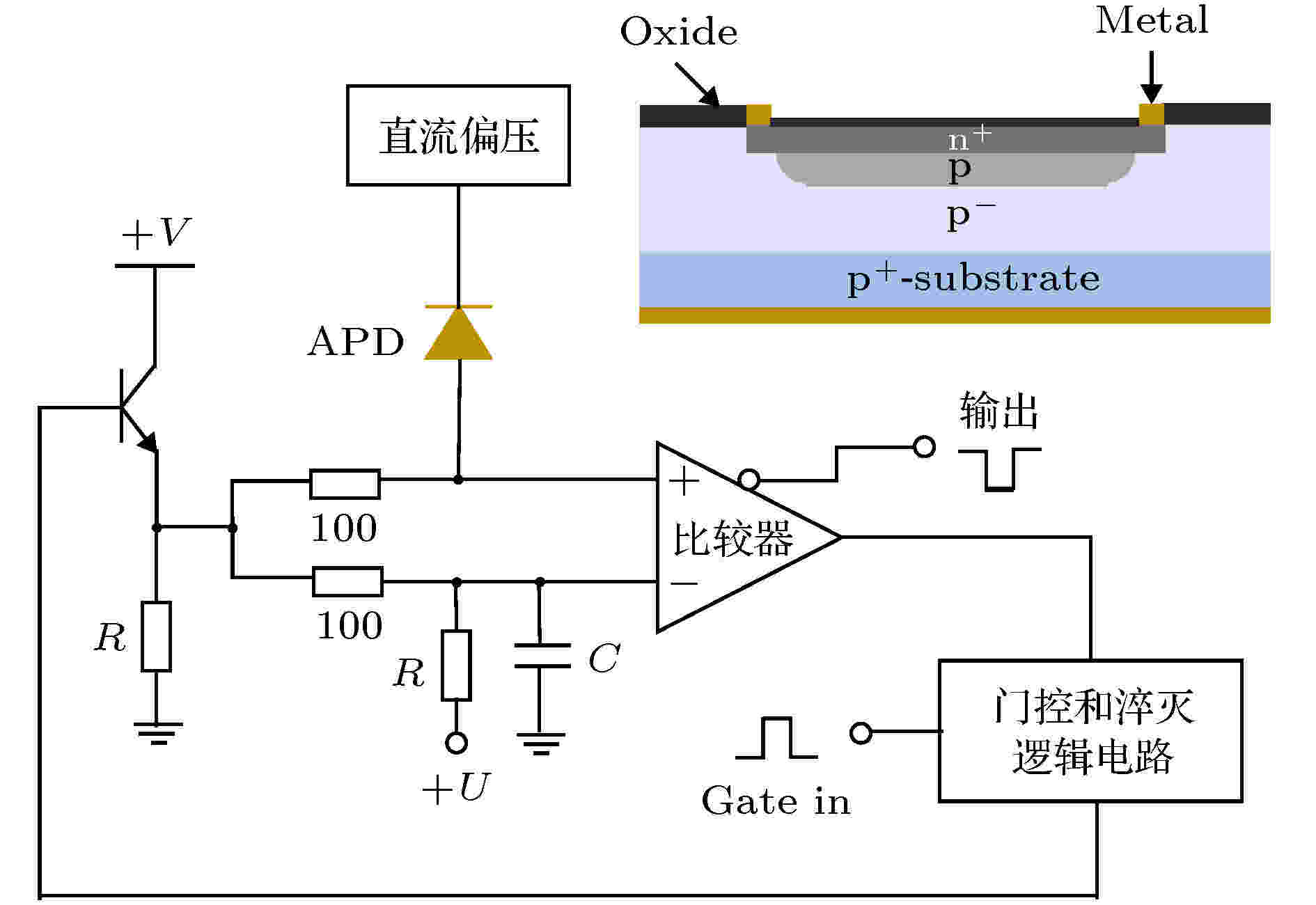
2020, 69 (7): 074204.
doi: 10.7498/aps.69.20191875
Abstract +
Avalanche photodiode single-photon detector is one of the ultra-sensitivity photoelectric detector, which has important applications in the fields of long-distance laser ranging, laser imaging, and quantum communication. However, due to the high temperature sensitivity of the avalanche voltage, the avalanche photodiode single-photon detector is prone to fluctuation of the avalanche gain when it works in the field environment, which leads to the delay drift and seriously reduces the time stability. In this paper, we proposed a method of stabilizing the delay of the single-photon detector. An embedded system was used to control avalanche photodiode at constant low temperature and compensate the delay drift of the detection circuit caused by the change of environment temperature in real time. A high time stability avalanche photodiode single-photon detector was realized by this method. In the experiment, the environment temperature changed from 16 ℃ to 36 ℃, and the avalanche photodiode was controlled at 15 ℃. After compensation, the delay drift of the avalanche photodiode single-photon detector was within ±1 ps, and the time deviation was 0.15 ps@100 s. This work is expected to provide an effective solution for the application of high-stability single-photon detector in the field and space environment.
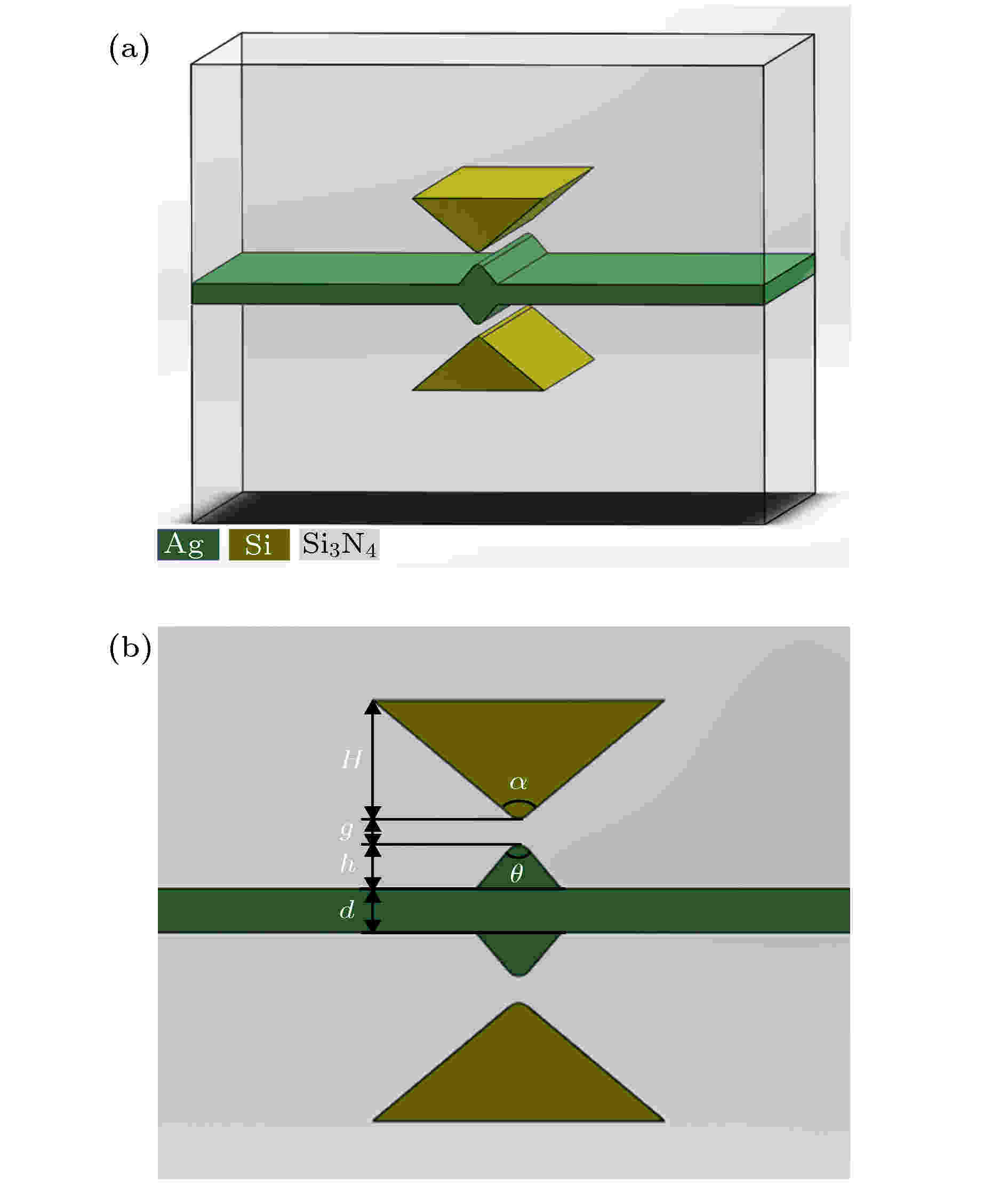
2020, 69 (7): 074205.
doi: 10.7498/aps.69.20191666
Abstract +
A symmetrical wedge-to-wedge THz hybrid SPPs waveguide (WWTHSW) with low propagation loss is investigated. The WWTHSW consists of two identical dielectric wedge waveguides symmetrically placed on each side of a micro wedge-patterned thin metal film. The mode characteristics of the WWTHSW, such as the propagation length (Lp), the normalized effective mode area (A) and the figure of merit (FOM) are analyzed by using the finite element method (FEM). Firstly, the influences of the height of Si micro wedge waveguide (H) and the gap between two wedges (g) on Lp and A are studied. For the same g, A first decreases and then increases with the increase of H. A achieves a minimum at an H of ~40 μm. However, Lp monotonically increases as H increases. The change of Lp slows down when H is greater than 40 μm. At a fixed H, Lp slightly increases with the increase of g. But A achieves a minimum when g is ~50 nm. Secondly, the dependencies of the mode characteristics of the WWTHSW on Si wedge tip angle (α) and Ag wedge tip angle (θ) are analyzed. At a fixed α, θ has less effect on Lp and A. As α increases at a fixed θ, Lp increases monotonically but A decreases firstly and then increases. A reaches a minimum when α increases to ~100°. Then, the change of Lp and A with the thicknesses of Ag film (d) and Ag wedge (h) are demonstrated. At a fixed h, both Lp and A slightly decrease as d increases. For the same d, Lp and A decrease with the increase of h. A for h = 0 μm is distinctly larger than those for h = 2 μm and h = 5 μm. According to the above optimizations, the parameters of the WWTHSW are chosen as d = 100 nm, g = 50 nm, h = 2 μm, θ = 80°, α = 100°, H = 40 μm. Under the optimal parameters, Lp of ~51 mm is obtained when Am reaches ~λ2/10280. Compared with the previous hybrid THz plasmonic waveguide, Lp of the WWTHSW increases by 3 times, and A decreases by an order of magnitude. This result reveals that the WWTHSW enables low-loss propagation and ultra-deep-subwavelength mode confinement at THz frequencies. At last, the coupling property of the parallel WWTHSW is investigated. The coupling length of ~8958 μm is achieved without the crosstalk between two parallel waveguides. By comparison, the WWTHSW has more advantages in terms of transmission and coupling characteristics than the previous micro wedge waveguide structure and bow-tie waveguide structure. In summary, due to the excellent transmission and coupling characteristics, the WWTHSW has great potential in the fields of optical force in trapping, biomolecules transporting, and in high-density integrated circuits design.

2020, 69 (7): 074206.
doi: 10.7498/aps.69.20191795
Abstract +
Surface magnetoplasmons (SMPs) is a kind of near-field electromagnetic wave, which propagates at the interface of dielectricand magneto-optical material under the action of biased magnetic field. Because SMPs have excellent anti-interference and backscattering-immune properties, it has attracted wide attention of researchers in recent years, but there are still many problems in the design of waveguide structures. When electromagnetic waves propagate in magneto-optical materials, the faraday rotation effect makes the bias magnetic field and the magnetic field vector (or electrical displacement vector) not in the same direction, so the anti-angle elements of the second-order matrix of magnetic permeability (or dielectric constant) are asymmetric. This asymmetrymakes electromagnetic waves non-reciprocal when propagating in specific directions in magneto-optical materials, and can even achieve one-way propagation in a certain frequency range. In this paper, a structure of three-layerplanar waveguide with silver, silicon, and magneto-optical material is studied. SMPs propagate at the interface between silicon and magneto-optical materials. This work numerically calculates the dispersion relation of the waveguide and the band gap of the magneto-optical material. It is found that both the fundamental mode and the higher-order mode of SMPs have one-way propagation characteristics in forward or backward directionwithin a specific frequency range. The dispersion relation of the planar waveguides with gyromagnetic material andgyroelectricmaterial are calculated respectively. As a result, the thickness of silicon layer and the external magnetic field have significant influence on bulk mode and the one-way propagation region of SMPs. By increasing the thickness of the silicon layer or increasing the intensity of the magnetic field, the higher-order mode can appear at the lower frequency region, thus compressing the one-way propagation region or even losing the one-way propagation mode. The one-way propagation bandwidth of planar waveguideswith gyromagnetic material YIG and gyroelectric material InSbare calculated. Bycalculating the dispersion relation of the waveguide SMPs and the band gap of the magneto-optical material for each group of magnetic field and the thickness of Si, the colormap of YIG waveguideand InSbwaveguide under 400–2000Oe magnetic field and 0.1–1 T magnetic field are obtained. As a result, the one-way mode of YIG waveguide appears in GHz band, and the maximum bandwidth for both forward and backward one-way propagation is 2.45 GHz. While, the one-way mode of InSbwaveguide appears in THz band, the maximum one-way propagation bandwidth in forward and backward directions are 3.9 THz and 3.12 THz. The research results in this paper are of great significance for the design and fabrication of non-reciprocal waveguides with one-waypropagation characteristics.

2020, 69 (7): 074301.
doi: 10.7498/aps.69.20191854
Abstract +
A method for analytically studying sound focusing in inhomogeneous waveguides is presented. From the viewpoint of acquiring the maximum acoustic pressure at an arbitrary position with normalized energy flux injection, optimal incident waves can be derived based on the multimodal admittance method. The method involves two steps. The first step is to expand the wave solution onto a complete orthogonal basis set so that the Helmholtz equation can be transformed into two sets of first-order coupled differential equations in the modal domain. The second step is to solve the coupled equations numerically by introducing admittance matrices and propagators, which can be used to derive reflection matrices and transmission matrices. Using the multimodal admittance method, one can circumvent the contamination caused by exponentially diverging evanescent modes and acquire stable wave solutions. Then the mapping between the acoustic pressure at an arbitrary position and that of the incident wave can be constructed, and this mapping changes the problem of wave focusing into solving the extrema of inner products in Hilbert space. The optimal incident waves that generate wave focusing at an arbitrary position can be readily computed together with the corresponding wave solutions. In this paper, we study the sound focusing in waveguides with varying cross-sections, scatterers and sound-speed profiles. The results show that the optimal incident waves will take full advantage of wave scattering caused by the boundaries and inhomogeneities during propagation to achieve the maximum pressure at foci, leading to good single-point and multi-point sound focusing performance. In addition, we find when injecting the spatially sampled optimal incident waves or the optimal incident waves with random perturbations, the resultant wave focusing phenomena will be still apparent. The focusing behaviors are highly robust to the perturbations of the moduli of the incident waves and slightly less robust to that of the arguments of the incident waves. Our method is also available for analyzing wave focusing in other kinds of inhomogeneous waveguides. We believe that our research can provide guidance on designing acoustic lenses or metamaterials to focus sound waves in complex media, and can offer inspiration in wave communications, imagings and non-destructive testing.
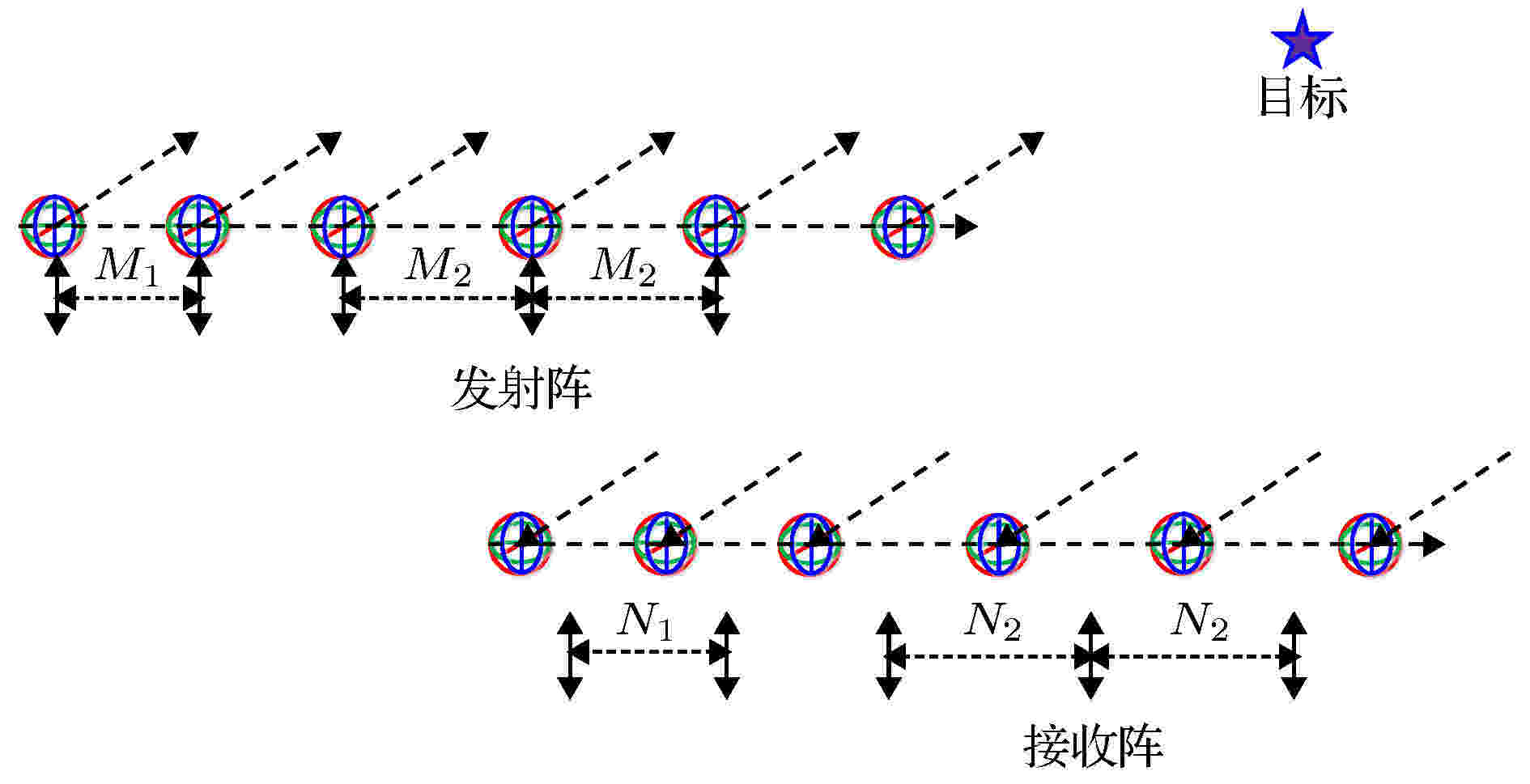
2020, 69 (7): 074302.
doi: 10.7498/aps.69.20191895
Abstract +
In this paper, a new sparse transmitting and receiving array is designed to improve the joint angle and polarization parameter estimation performance for bistatic electromagnetic vector sensors Multiple-Input Multiple-Output radar. Firstly, large array aperture can be obtained with the aid of the sparse transmitting and receiving array. Then, an effective third-order tensor model is constructed in order to make full use of the multidimensional space-time characteristics of output data after matching filtering. And, the Parallel Factor trilinear alternating least square algorithm is proposed to deal with the constructed third-order tensor model, which can yield closed-form automatically paired two dimensional Direction of Departure and two dimensional Direction of Departure estimation without additional angle pair matching process. Furthermore, two sets of high accuracy rotation invariance relationships corresponding to transmit elevation angle and receive elevation angle can be achieved by using the estimated transmit steering vector matrix and receive steering vector matrix. After the accuracy transmit elevation angle and receive angle are obtained, the corresponding transmitting and receiving azimuth angle, polarization angle and polarization phase difference can be accurately estimated by using the vector-cross-product algorithm. Compared with existing algorithms, the proposed algorithm can avoid high dimensional eigenvalue decomposition and additional parameter matching process. Moreover, the high estimation performance of the proposed can be further guaranteed by using the designed sparse array. Finally, simulation results demonstrate the effectiveness and superiority of the proposed method in terms of estimation accuracy and angle resolution.

2020, 69 (7): 074501.
doi: 10.7498/aps.69.20191505
Abstract +
In the past few decades, although coupled-mode theory (CMT) has been extensively studied in quantum system, atomic system, plasmon system, circuit system, and so on, the theoretical origin is still plaguing many researchers. In the book of waves and fields in optoelectronics, the second-order differential equations of the simplest LC simple harmonic vibration circuit was turned into the first-order differential equation using the method of variable substitution by Haus. However, there is not loss in the simplest LC simple harmonic vibration circuit, loss term is introduced by qualitative analysis. Although this method of dealing with problems has no problems from a physical point of view, it is not rigorous enough from a mathematical point of view. In this paper, based on the secular perturbation theory, the well-known spring oscillator model is degenerated into two-mode CMT. Starting from the second-order differential equations of the spring oscillator model, the secular perturbation theory is used to obtain first order differential equations of two-mode CMT. The results show the relationships between each term’s coefficients in two-mode CMT and the physical quantities in Classical Mechanics are established by using the secular perturbation theory. Through solving two-mode coupled-mode equations, the energy transfer efficiency has been obtained. To verify the correctness of two-mode CMT, we design a coupled tuning fork mechanical vibration system, which consists of two experimental instruments to provide driving force and receive signals, two tuning forks and springs. The amplitude spectra are measured by an experimental instrument of forced vibration and resonance (HZDH4615), which provides a periodic driving signal for the tuning fork. To clarify the mechanism of the spectra, the numerical fitting has been performed by mathematica software based on the energy transfer efficiency. Theoretically, the obtained fitting parameters can also evaluate some important attributes of the system. The theoretical results are in close correspondence with the experiment. That is to say, two-mode CMT is suitable for classical vibration system.This study provides a more rigorous derivation for each term’s origin in two-mode CMT, and has guiding significance in the theoretical research of linear coupled vibration system.
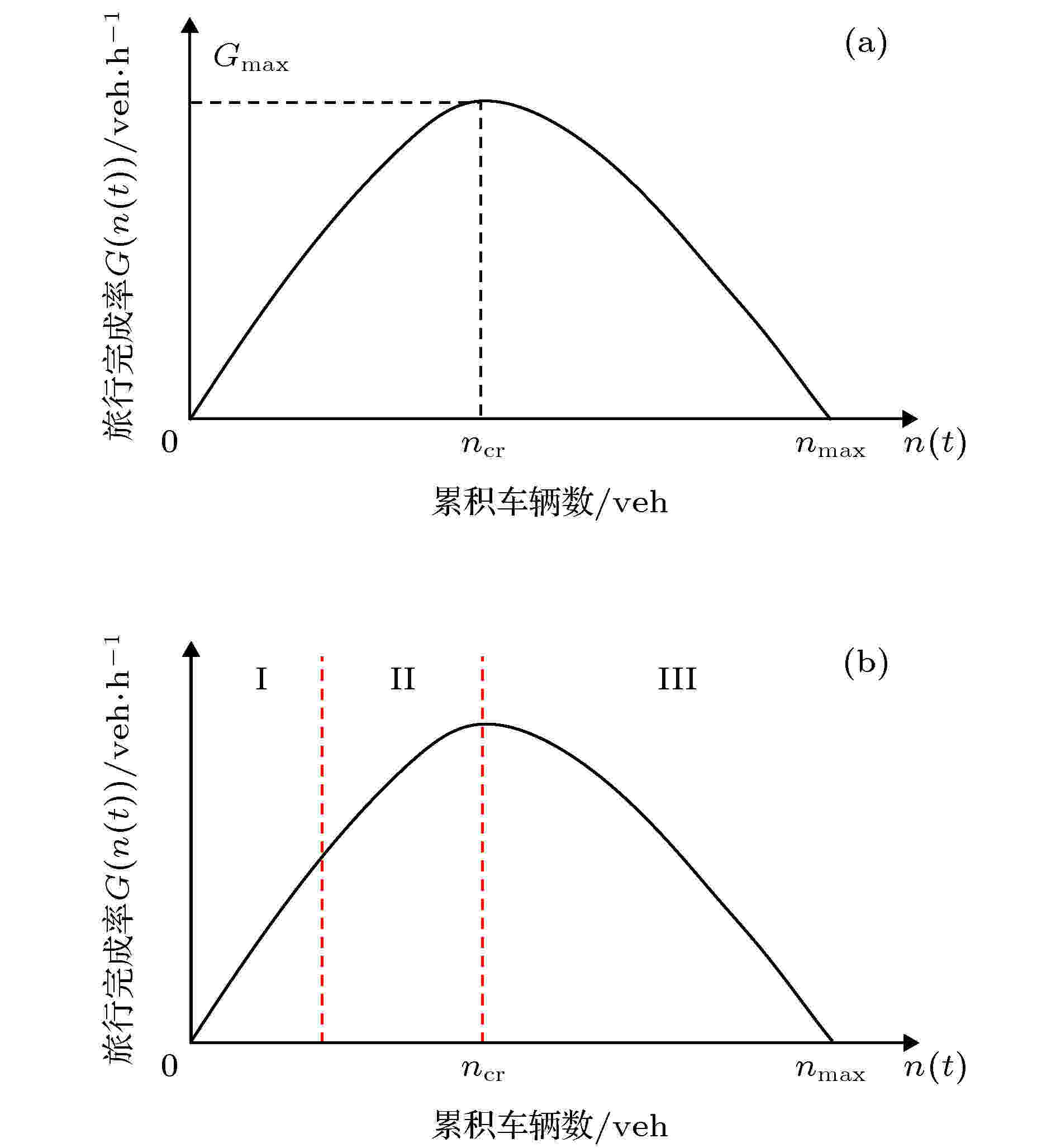
2020, 69 (7): 074502.
doi: 10.7498/aps.69.20191641
Abstract +
The macroscopic fundamental diagram (MFD), which can describe the macroscopic state of a regional network intuitively, describes a unimodal, statistical and reproducible relationship between accumulation and the trip completion flow of a region. Existing researches have proved that using MFD characteristics can ‘metering’ the boundary flow and relieve the traffic congestion problem effectively. As the foundation of traffic control, existing studies on the characteristic of MFD have proved that external origin to destination demand does not influence the MFD distribution. However, the traffic generation and attraction sources in the regional road networkwill changes the distribution of traffic density of the road network, thus affecting the characteristic of MFD. However, to date, no related analysis explored the influence of the traffic generation and attraction sourcesin the regional road network. To solve this problem, according to the spatial and temporal distribution of traffic generation and attraction sources in the regional road network, this paper puts forward an aggregation degree index analysis model of traffic generation and attraction sources, based on the dynamic parameters of traffic generation and attraction sources, and section traffic impedance. Taking a square-format road network as the target, nine groups of schemes for different traffic generation and attraction sources are designed. Two conclusions can be drawn after comparing the MFD curve of the road network under different aggregation degree index of traffic generation and attraction sources: (1) when the traffic flow of the road network is in the state of free flow or critical flow, the aggregation effect of traffic generation and attraction sources has no effect on MFD distribution; (2) when the traffic flow of the road network is in the congestion flow state, the aggregation effect of traffic generation and attraction sources influences MFD distribution. Moreover, under the same road network flow conditions, the aggregation degree of traffic generation and attraction sources is lower in the road network (the distribution of traffic generation and attraction volume is more balanced), the trip completion flow of road network will be higher. Otherwise, the aggregation degree of traffic generation and attraction sources is higher in the road network (the distribution of traffic generation and attraction volume is more unbalanced), the trip completion flow of road network will be lower.

2020, 69 (7): 074701.
doi: 10.7498/aps.69.20191836
Abstract +
Rayleigh-Bénard (RB) convection in binary fluid mixtures, which shows rich and interesting pattern formation behavior, is a paradigm for understanding instabilities, bifurcations, self-organization with complex spatiotemporal behavior and turbulence, with many applications in atmospheric and environmental physics, astrophysics, and process technology. In this paper, by using a high-order compact finite difference method to solve the full hydrodynamic field equations, we study numerically the RB convection in binary fluid mixtures such as ethanol-water with a very weak Soret effect (separation ratio $\psi=-0.02$ ) in a rectangular container heated uniformly from below. The direct numerical simulations are conducted in the rectangular container with aspect ratio of $\varGamma=12$ and with four no-slip and impermeable boundaries, isothermal horizontal and perfectly insulated vertical boundaries. The bifurcation and the origin and evolution of pattern in RB convection for the considered physical parameters are studied, and the bifurcation diagram is presented. By performing two-dimensional simulations, we observe three stable states of Blinking state, localized traveling wave and stationary overturning convection (SOC) state, and discuss the transitions between them. The results show that there is a hysteresis in the transition from the Blinking state to the localized traveling wave state for the considered separation ratio, and the evolution of the oscillation frequency, convection amplitude and Nusselt number are discontinuous. Near the lower bound of the Rayleigh number range where the Blinking state exists, a asymmetric initial disturbance is the inducement for the formation of the Blinking state. Inside the range, its inducing effect is weakened, and the oscillatory instability becomes the main reason. It is further confirmed that reflections of lateral walls are responsible for the survival of the stable Blinking state. With the increase of the Rayleigh number, the critical SOC state undergoes multiple bifurcations and forms multiple SOC states with different wave numbers, and then transitions to a chaotic state. There are no stable undulation traveling wave states at both ends of the critical SOC branch.
PHYSICS OF GASES, PLASMAS, AND ELECTRIC DISCHARGES
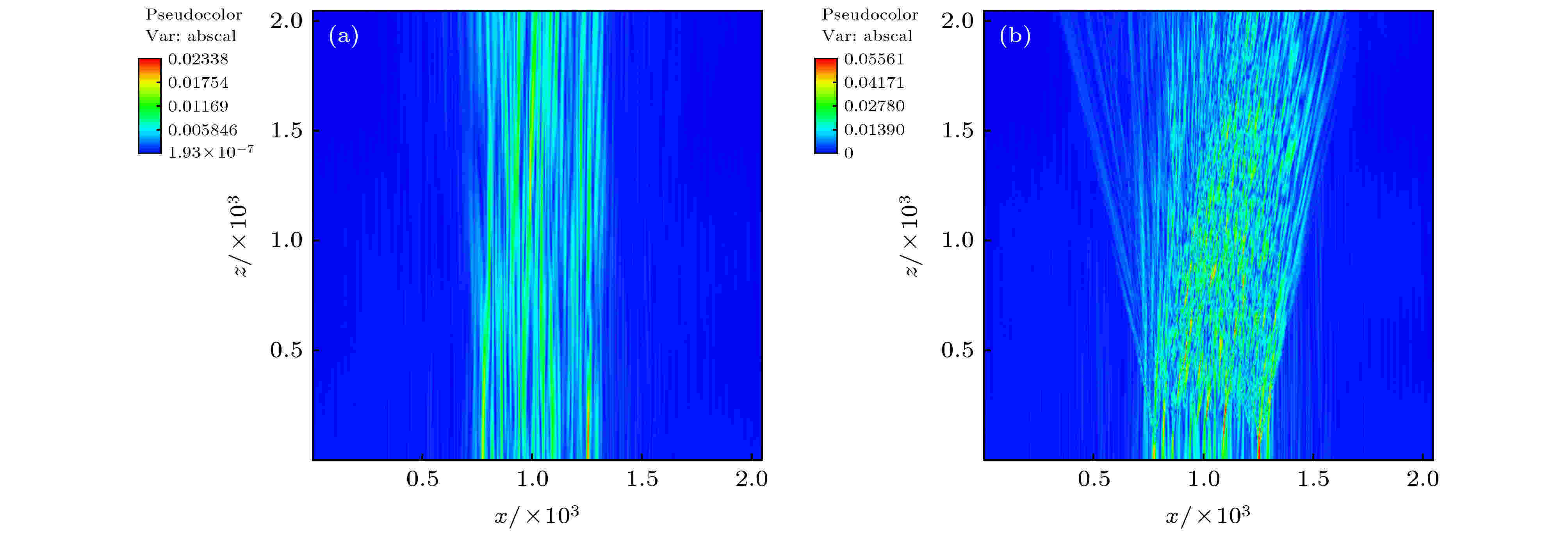
2020, 69 (7): 075201.
doi: 10.7498/aps.69.20191639
Abstract +
When it reaches high energy density state, new features of laser propagation in plasma arises in the contrast to that of research field in classical optics. Such as beam deflection, a laser beam can change its propagation direction while it comes across a transverse plasma flow. On the other hand, employment of all sorts of smoothed laser beams becomes very common in high power laser facilities for high energy density physics experiments. Therefore, on what condition beam deflection comes into play for smoothed beams are necessary to be investigated. This paper presents numerical simulation results for that, which is performed by laser plasma interaction code LAP3D. It is a three dimensional massively parallel code, including a laser paraxial envelope solver and a nonlinear Eulerian hydrodynamics package, and models for filamentation, stimulated Raman scattering and stimulated Brillouin scattering, with beam smoothed by continuous phase plate (CPP), spectral dispersion (SSD), separately. For simplicity in this study, numerical simulations perform in a about 700 μm × 700 μm × 700 μm plasma using isotropic conditions (Te = 3 keV, Ti = 1 keV, n = 0.1 nc) and only include refraction and diffraction effects, namely, with filamentation model excluding scattering models. Simulation employs the CPP and the SSD beam as representatives of spatial and temporal smoothed beams, respectively, and uses an oval like focused spot with extension in the long axis direction about 200 μm in the focus plane propagating through the left boundary into the simulation domain. Based on our previous investigations, we assume that beam deflection of a smoothed beam becomes effective when it satisfies two following conditions as that for a Gaussian beam, namely, suffering filamentation and facing a transverse plasma flow at ion sound speed. Simulation results of LAP3D confirm that both spatial and temporal smoothed beams suffer beam deflection when two above conditions are both satisfied. For the case of CPP smoothed beam, simulation results show that it suffers evident beam deflection under the conditions that it suffers filamentation when its average intensity is larger than that of filamentation threshold, and faces a transverse plasma flow at ion sound speed. For the case of SSD smoothed beam, simulation results show that the beam can avoid beam deflection even if it faces a transverse plasma flow at ion sound speed when filamentation is suppressed as beam bandwidth is much larger than the growth rate of filamentation, otherwise it suffers beam deflection.
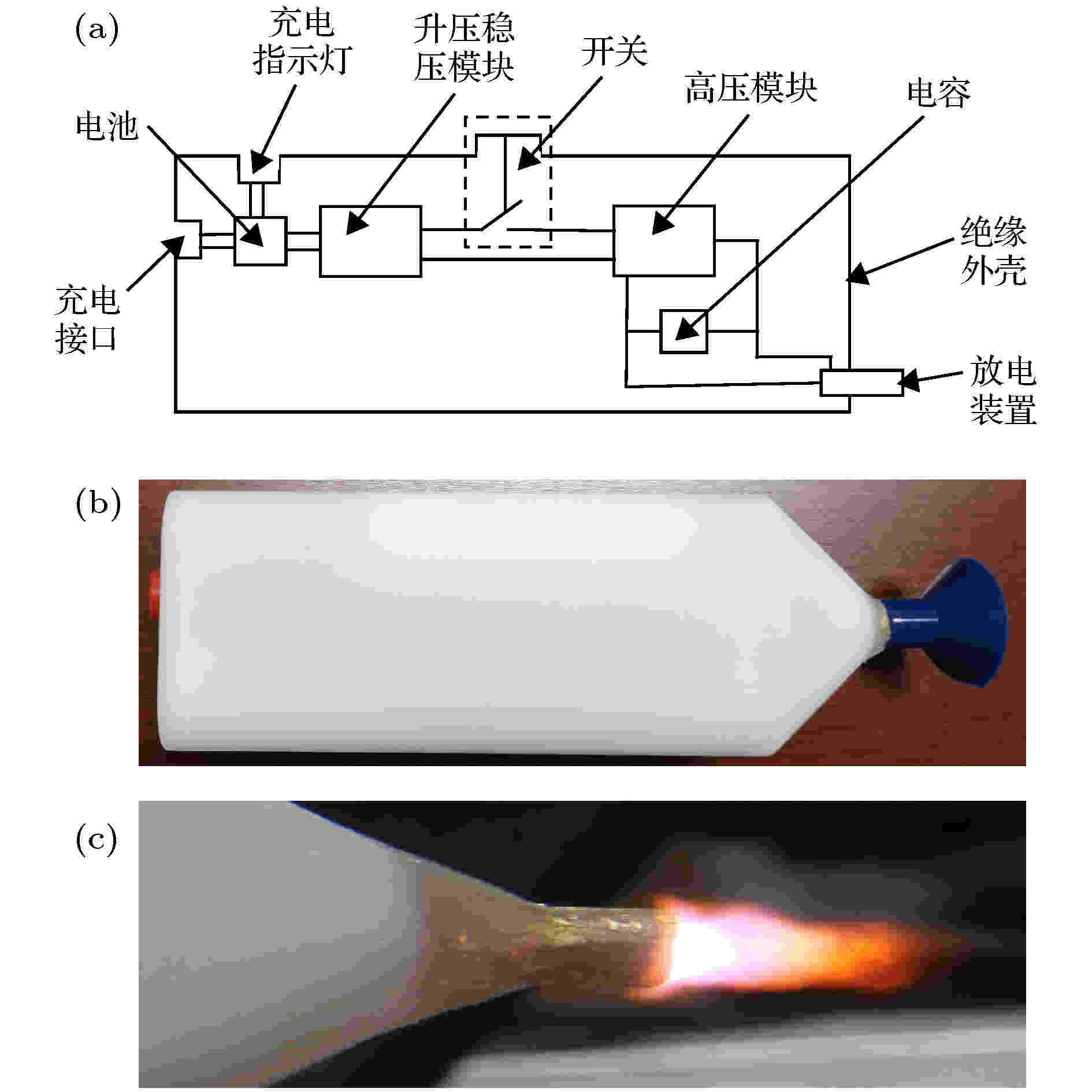
2020, 69 (7): 075202.
doi: 10.7498/aps.69.20191909
Abstract +
It is difficult in measuring the electron density of an atmospheric air spark shock wave plasma jet, due to its variation on the time scale of sub-microseconds. In this paper, the time-varying electron density of air spark shock wave plasma jet is measured, based on the principle of microwave Rayleigh scattering. The system constant A is determined by using calibration of materials with known properties; the results show that the system constant is obtained as A = 1.04 × 105 V·Ω·m–2. According to the principle of microwave Rayleigh scattering, the electron density of the plasma jet is related to its radius and length of the plasma jet plume. Combined with the discharge image captured by ICCD camera, it is observed that the plasma jet plumes are with irregular patterns. In order to facilitate the calculation, the plasma jet plumes are replaced by cylinders with the same volume as the original shapes. Thus, the equivalent radius and length of the plasma jet plume are obtained. According to the known data, the electron density is determined to be in the order of 1020 m–3; its value increases rapidly to the peak value, and after then exponential attenuates along with time. In addition, the effect of different equivalent dimensions of the plasma jet plume on the measurement results is also discussed. It is shown that the calculation result with the time-varying equivalent radius and the time-varying equivalent length is the most effective one. In addition, the first fast peak is caused by the ionization wave of the photo ionization. The actual ionization process is that the air discharge in the cathode cavity releases a large number of high energy photons, which pass through the cathode nozzle and project into the region outside the nozzle; and then the O2 molecule in the ambient air are ionized by those high energy photons to form the plasma jet plume at the time of 1 μs.

2020, 69 (7): 075203.
doi: 10.7498/aps.69.20191797
Abstract +
In this paper, discharge characteristics of a planar copper wire array explosion driven by a microsecond pulsed current source (500 J stored energy) in atmospheric air medium were studied. Meanwhile, controlled experiments were performed with single wire cases. With a 2 cm distance between electrodes, 2-16 copper wires with a diameter of 100 μm were selected to form planar copper wire arrays, and single copper wires with diameter of 50-400 μm were selected for comparisons. Load voltage, circuit current and light radiation intensity were measured. Electric power and deposited energy were calculated. The experimental results show that for the single wire case, with the increase of mass (diameter), the process of vaporization and ionization become slower, manifested as a delay of the voltage peak and an increase of the full width half maximum (FWHM) of the voltage pulse from 0.07 μs to 0.64 μs. In contrast, although the explosion time of wire array load was delayed with the increase of mass, the duration of vaporization and ionization did not change significantly with a FWHM of 0.11 ± 0.01 μs. In addition, the deposited energy of wire array load before breakdown was lower than that of single wire load with the same mass. As for the optical radiation intensity, under three cases with the same mass, the peak intensity of wire array explosion is about 28%, 49% and 52% higher than that of single wire explosion. There may be two reasons which cause the difference between the single wire load and wire array load. First, the larger specific surface area of the wire array load makes faster phase transitions. Second, the development of thermal or magnetohydrodynamics for the two kinds of loads was different, which should be responsible for the differences in energy deposition and optical emission.
CONDENSED MATTER: STRUCTURAL, MECHANICAL, AND THERMAL PROPERTIES
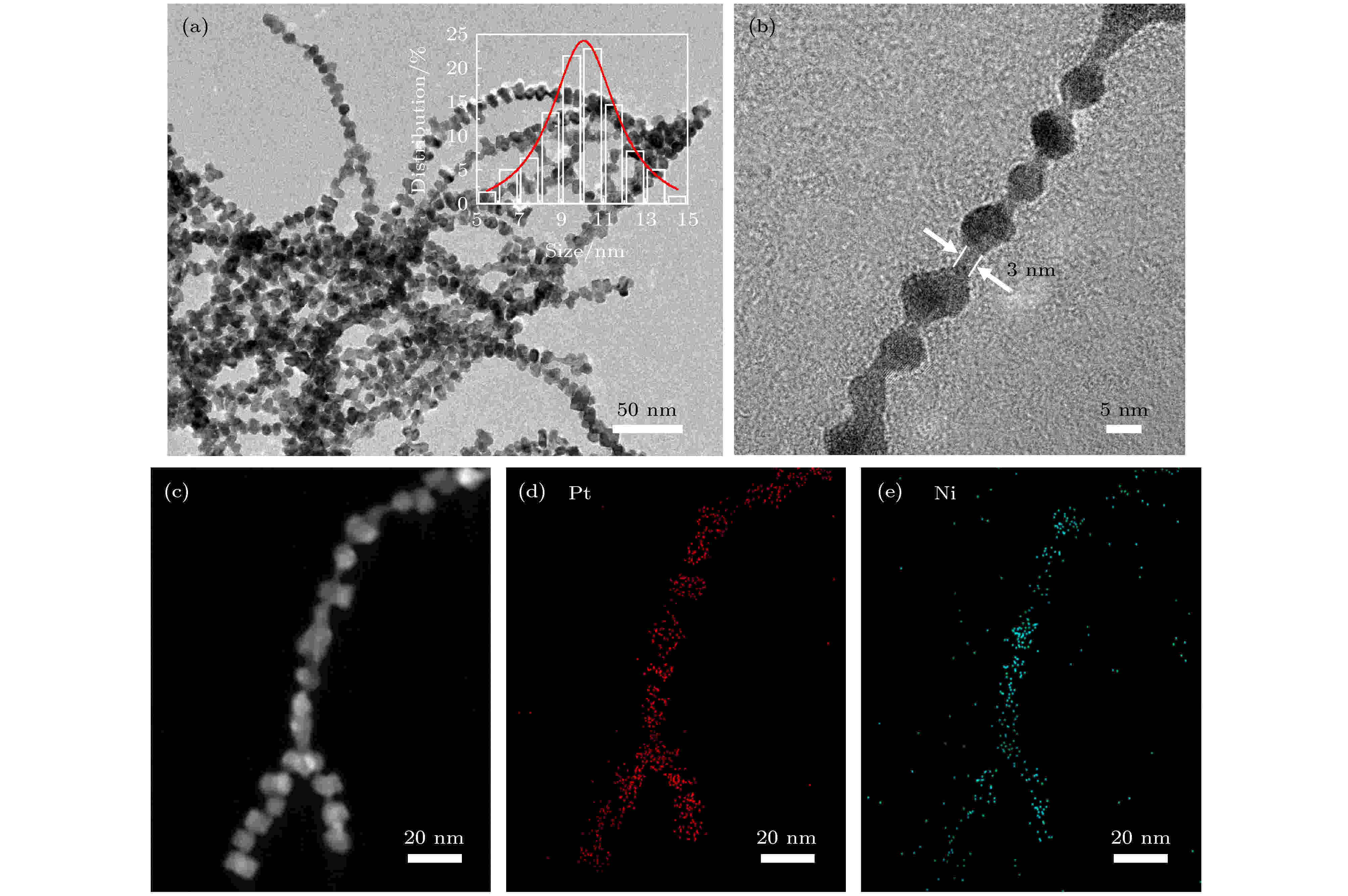
COVER ARTICLE
2020, 69 (7): 076101.
doi: 10.7498/aps.69.20200343
Abstract +
Fuel cells are one of the promising energy-conversion devices due to their high efficiency and zero emission. Despite tremendous research works in past decades, there remains a tough challenge in realizing the commercial applications of fuel cell technologies. Therefore, the development of highly efficient and stable fuel cell electrocatalyst is the top priority for practical fuel cells. As we all know, the small-size nanoparticles always have high specific surface area, which can provide more active sites to enhance the catalytic activity, while the one-dimensional nanowires usually own high structural stability. It may provide a possibility for the design of a novel bimetal Pt-based alloy nanostructure by combining the structural superiority of both, which can maintain the high stability and maximize the catalytic activity at the same time. Driven by these purposes, a novel nanostructure constructed by Pt-Ni alloy nanoparticles with a one-dimensional chain structure was designed to balance the contradiction between the activity and stability due to the size effects (the smaller the size, the higher the activity, and the worse the stability of the nanocatalyst; and vice versa). Here, a simple one-step solvothermal method has been adopted to produce the novel nanostructures constructed by the chain-like Pt-Ni nanoparticles (Pt-Ni CNPs) with Pt-rich crystal faces and alloy nature. The structure, component and catalysis were investigated by the combination of X-ray diffraction, transmission electron microscopy, X-ray photoemission spectra, and electrochemical measurements. The results show that the as-synthesized Pt-Ni CNP is constructed from a nanowire (with a diameter of about 3 nm and a length of several hundred nanometers) and the nanoparticles (with an average diameter of about 10 nm). This nanostructure is cleverly integrated the structural advantages of one-dimensional nanowires and zero-dimensional nanoparticles, which can significantly enhance the catalytic activity and stability for the methanol oxidation reaction (MOR) in acidic environment. Specially, the mass activity and specific activity of as-prepared Pt-Ni CNPs are 5.7 and 7.6 times higher than those of the commercial Pt/C, respectively. After 1000 cycles of cyclic voltammetry (CV) measurement, Pt-Ni CNPs still retain 91.2% of the specific activity, while the commercial Pt/C undergoes a drastic loss of MOR activities, retaining only 4.4% of the initial activity. It is particularly noteworthy that this nanostructure of Pt-Ni CNP solves the problem of agglomeration of nanoparticle catalysts in the reaction, and provides a new approach to obtain Pt-based nanocatalysts with high catalytic activity and stability at the same time. Our finding will provide insight into more rational designs of Pt-based bimetallic nanocatalysts with one-dimensional architectures, which is expected to promote the further development and large-scale industrial application of the direct methanol fuel.
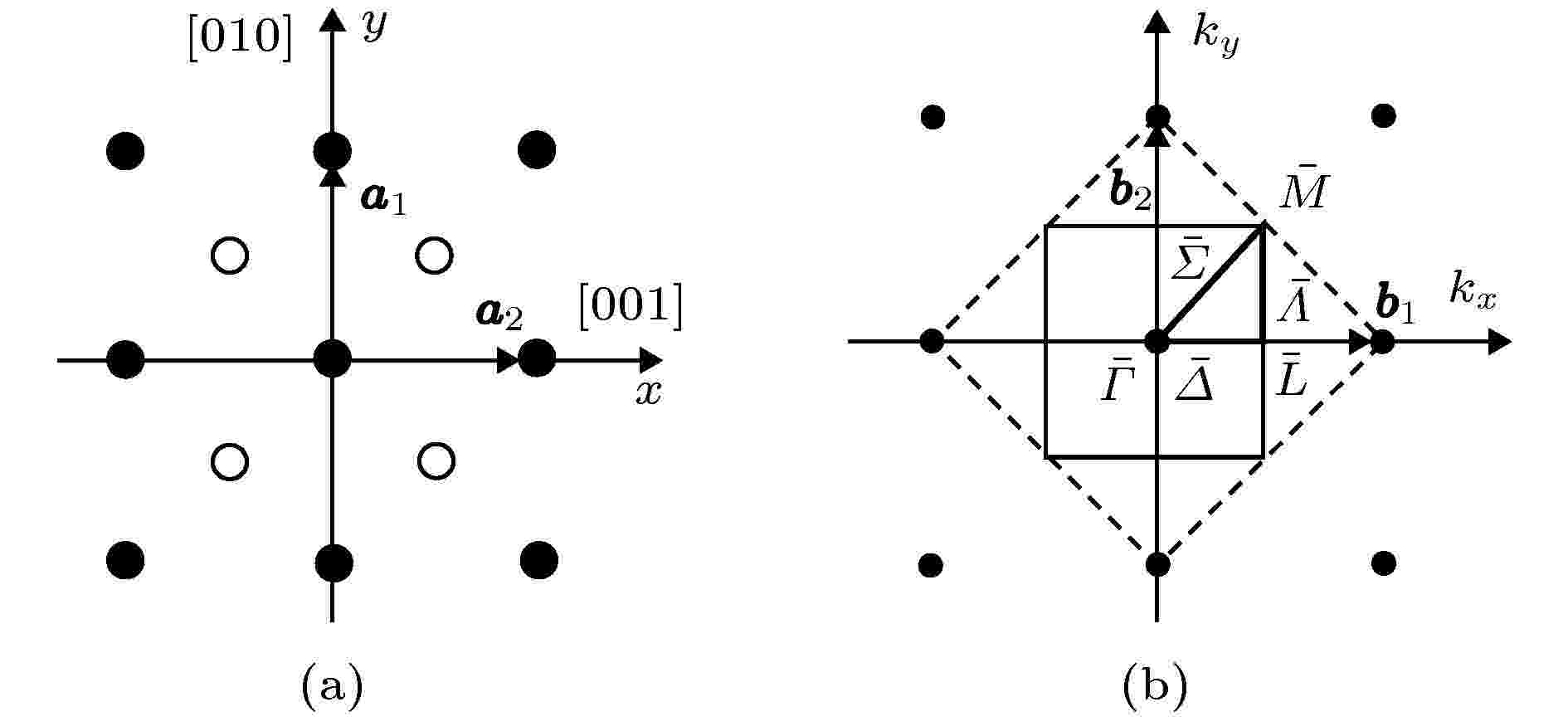
2020, 69 (7): 076301.
doi: 10.7498/aps.69.20191910
Abstract +
Based on the theory of surface lattice dynamics, the surface phonon spectrums along three symmetrical directions of $\bar \varGamma \bar L$ , $\bar L\bar M$ and $\bar \varGamma \bar M$ are simulated for the W(100) surface by using the modified analytic embedded atom method. The polarization vectors at different symmetrical points are also calculated. According to the criterion and marking method of surface mode, the surface modes along different symmetrical directions are drawn, the distribution range and mode coupling of surface modes are discussed as well. The vibration frequencies of surface modes calculated by us have been compared to available experimental datum and some theoretical values correspondingly. The results display that the present results are general agreement with the referenced experimental or theoretical results. Based on the calculated polarization vector, the surface vibration states are constructed for the atomic layers in the neighboring surface. And the polarization and local features of the surface modes along different symmetrical directions are analyzed. The results show that there are some coupling phenomena between surface mode dispersion, such as avoid crossing and independence crossing. The avoid crossing is found between the surface-mode branch S1 and the surface-mode branch S2 near ${\bar \zeta _y} = 0.32$ along $\bar L\bar M$ direction. In the region, going from $\bar L$ to $\bar M$ , S1 changes from y polarization to z polarization, and S2 changes from z polarization to y polarization. The independence crossings exist between surface-mode branch S1 and surface-mode branch S2 at ${\bar \zeta _x} = 0.5$ along $\bar \varGamma \bar L$ direction, and surface-mode branch S2 and surface-mode branch S3 at ${\bar \zeta _x} = 0.5$ along $\bar L\bar M$ direction, respectively. Before and after the crossings, the polarization and local features of the surface modes have not changed. Inspection of the polarization vectors, the coupling phenomena are iconically demonstrated.
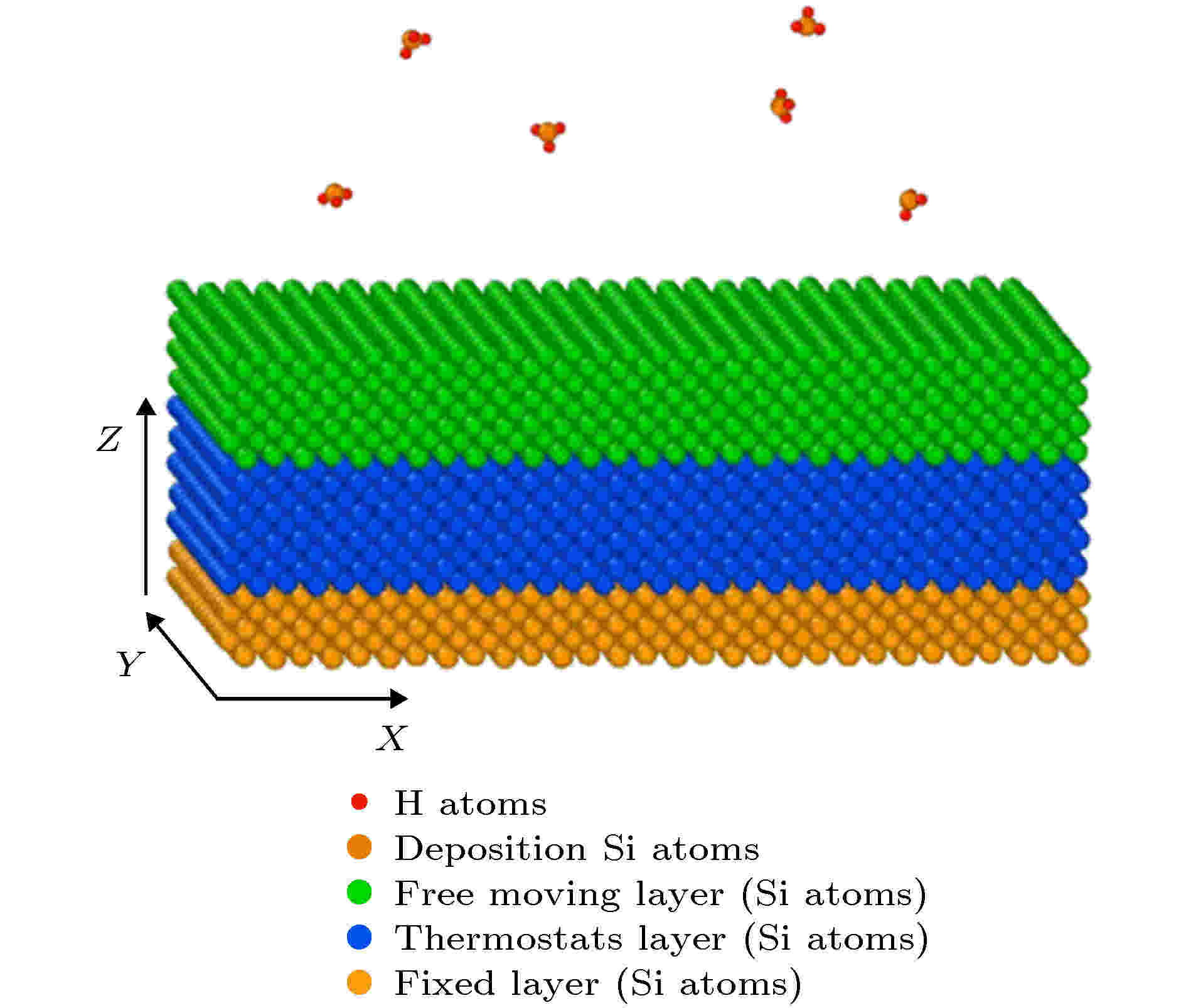
2020, 69 (7): 076801.
doi: 10.7498/aps.69.20191275
Abstract +
The hydrogenated amorphous silicon (a-Si:H) film is the core structure of hetero junction with intrinsic thin layer solar cell. Its quality determinates the photoelectric conversion efficiency of this solar cell directly. The configuration of SiyHx is an important structure characteristic of a-Si:H films, and it can influence on the quality of a-Si:H thin films and their application properties. However, it is difficult to study them in depth and detail by the existing analytical and testing methods. In this paper, the structure configuration of SiyHx in a-Si:H /c-Si thin films and the effect of substrate temperature on its content have been simulated and analyzed by molecular dynamics method. A modified Tersoff potential developed by Murty was used to calculate the inter-atomic forces. The results showed that the SiyHx structure in a-Si:H thin films can be summarized into six configurations. Three traditional configurations, including SiH, SiH2 and SiH3, can be referred to as SiHx configurations.The other three nove configurations, including HSi2(s), HSi2(l) and HSi3, can be referred to as HSiy configurations. The main differences between the configurations of HSi2(l) and HSi2(s) are the longer Si—H bonds and bigger bond angle in HSi2(l) configuration than those in HSi2(s) configuration. All of the Si-H bonds in SiHx configurations are strong chemical bonds, while the Si—H bonds in HSiyconfigurations are weak physical bonds. The further calculations of the Si-H bond energies in six configurations have been carried out by the first principle method. According the bond energies results, we can deduce that the order of the stability of six configurations from high to low is SiH > SiH2 > SiH3 > HSi2(s) > HSi2(l) > HSi3. Comparing the Si—H bond energies of the six configurations with the solar energy, it is found that the Si-H bond energy in HSiy configuration is in the range of visible and infrared light in solar light. Si—H physical bonds are easy to fracture in HSiy configuration caused by solar light. This may be the main mechanism of producing Steabler-Wronski (S-W) effect in amorphous silicon thin film cells. In addition, the rise of substrate temperature in the deposition process of a-Si:H films will lead to a significant decrease in the configuration content of all kinds of SiyHx configurations.
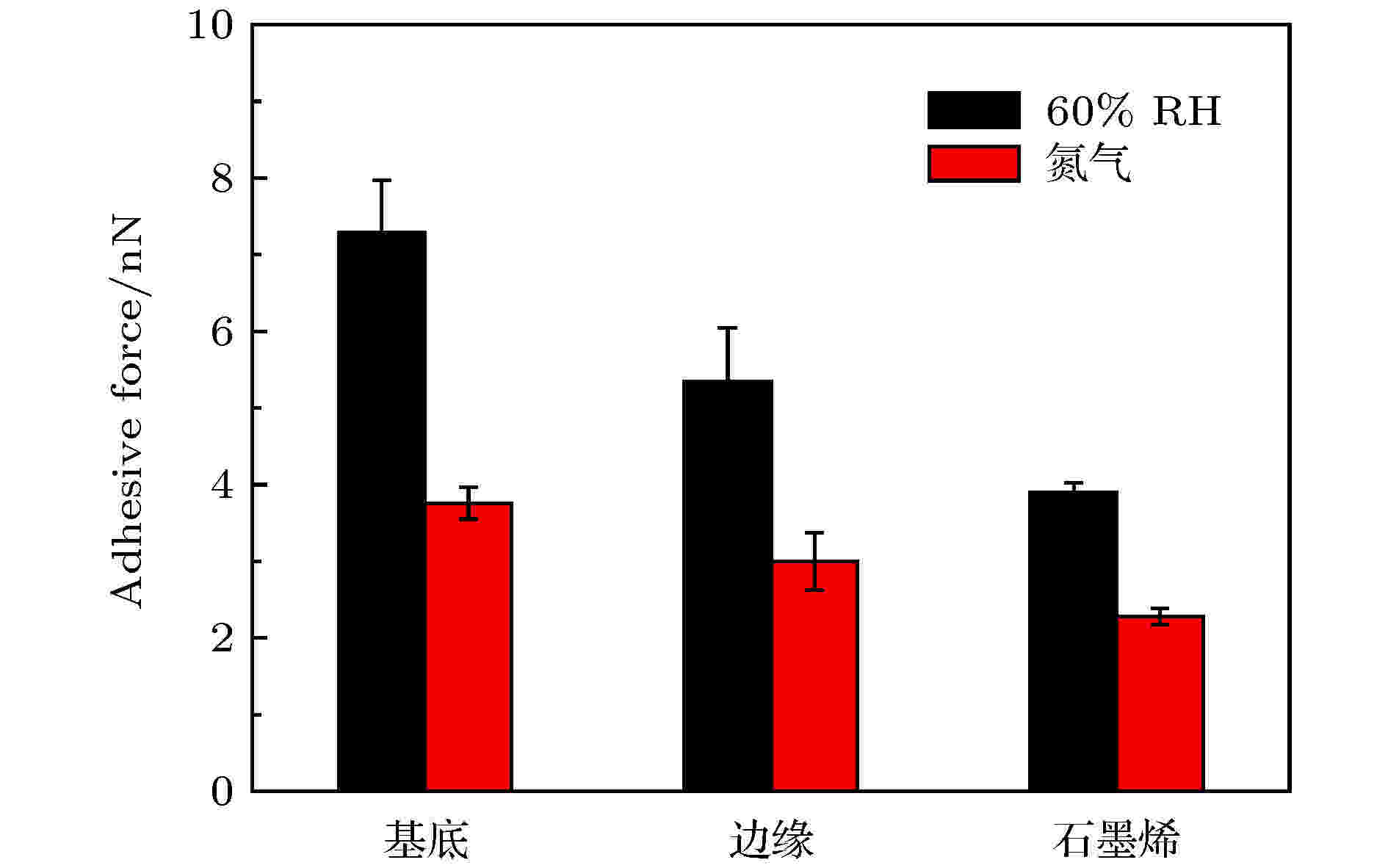
2020, 69 (7): 076802.
doi: 10.7498/aps.69.20191825
Abstract +
Atomic force microscope was used to study the adhesion of mechanical exfoliated graphene under two different atmosphere conditions, air and nitrogen. It was found that the adhesion under nitrogen was smaller. The adhesion of graphene edge was larger than that of the inner region. The relationship between the adhesion of folded graphene and the number of layers along with its frictional properties were investigated under nitrogen atmosphere. The results showed that the adhesion was independent of the number of folded graphene layers. The frictional properties of each area of the folded graphene were far beyond the SiO2 substrate. The friction coefficients of the single layer, the fold on single layer, the double layers and the fold on double layers regions were successively decreased, which were 0.049, 0.031, 0.023 and 0.021 respectively. The friction forces were successively decreased as well. The frictional property of the folded graphene was weaker than the unfolded graphene of same number of layers due to the weaker bonding force between the layers. When measuring the adhesion with a sharp tip or a ball tip, the measurement history of adhesion had little influence on subsequent adhesion. Studies on freshly folded graphene in the air showed that the friction force of the folded region was significantly higher than that of the unfolded region.
CONDENSED MATTER: ELECTRONIC STRUCTURE, ELECTRICAL, MAGNETIC, AND OPTICAL PROPERTIES

2020, 69 (7): 077301.
doi: 10.7498/aps.69.20191871
Abstract +
The Su-Schrieffer-Heeger (SSH) is a typical one-dimensional system with topological edge states, which has been experimentally realized in the photon and cold atom systems.Therefore, how to confirm the existence of the edge states from theoretical and experimental has become one of the most important topics in condensed matter physics. In this paper, using the tight-binding approximation and transfer-matrix method, we have studied the transport signatures of electron through a quantum dot-SSH chain hybrid system. Here,the two quantum dots play a role in modulating the tunneling coupling strength between the SSH chain and the two electrodes.When the quantum dots are weakly coupled to the SSH chain, the quadruple-degenerate edge states of the quantum dot-SSH chain hybrid system correspond to that the SSH chain has two degenerate zero-energy edge states; whereas the twofold-degenerate ones correspond to that the SSH chain has no edge states. While the quantum dots are strongly coupled to the SSH chain, the edge states only exist when the intra-cell hopping amplitude is larger than the inter-cell hopping amplitude. In this situation, however, there is no edge states in the SSH chain. In particular, when the quantum dot-SSH chain hybrid system is strongly coupled to the two external electrodes, the number of transmission resonance peaks of the edge states of the quantum dot-SSH chain hybrid system will be reduced by 2. For example, in the case of the quadruple-degenerate edge states, the number of transmission resonance peaks will be two; whereas in the case of twofold-degenerate ones, that will disappear. Therefore, by modulating the tunneling coupling strength between the quantum dots and the SSH chain and that between the quantum dots and the two external electrodes, we can observe the variation of the number of transmission resonance peaks of edge states to detect whether the SSH chain is in the nontrivial topological state or not.

EDITOR'S SUGGESTION
2020, 69 (7): 077302.
doi: 10.7498/aps.69.20191931
Abstract +
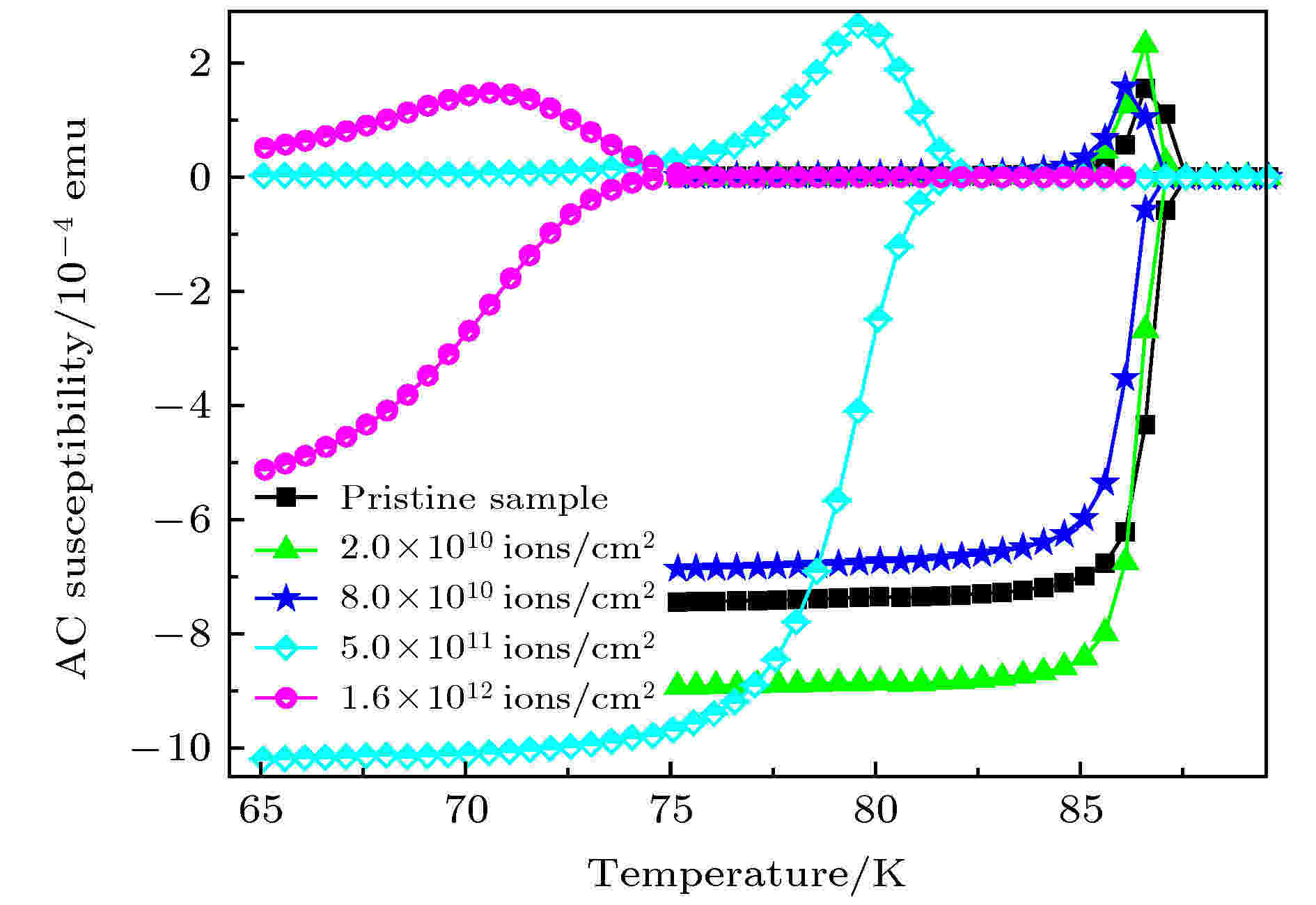
2020, 69 (7): 077401.
doi: 10.7498/aps.69.20191914
Abstract +
YBa2Cu3O7−δ (YBCO) high temperature superconductor materials have many promising applications in energy, transportation and so on. Nonetheless, the application of YBCO in high magnetic field was limited because of low critical current. One-dimensional latent tracks produced by swift heavy ions irradiation can be effective pinning centers, thus enhancing superconductivity in external field. YBCO high temperature superconducting films were irradiated with 1.9 GeV Ta ions at room temperature and vacuum condition. Structure damages in irradiated samples were characterized by transmission electron microscopy (TEM). Continuous amorphous latent tracks, with diameter from 5 nm to 15 nm, throughout the whole superconducting layer can be observed from TEM images. Physical property measurement system (PPMS) was used to measure superconducting properties of samples before and after irradiation. When irradiated at optimal fluence of 8 × 1010 ions/cm2, critical current reaches its maximum value and pinning force was twice of unirradiated sample, while critical temperature almost unchanged. The analysis of experimental results shows that latent tracks produced by swift heavy ions irradiation can enhance in-field current-carrying capability, without decreasing critical temperature. In the power-law regime ${J_c} \propto {B^{ - \alpha }}$ values of ɑ decreased with the increasing of fluence, indicating a weaker magnetic field dependence of critical current. ɑ reaches its lowest value 0.375 when irradiated at a fluence of 5.0 × 1011 ions/cm2, corresponding to a lowest in-field Jc. This result may be a combination of increasing pinning centers and decreasing superconductor volumes that work together. Normalized pinning force fp = Fp/Fp,max of sample irradiated with different fluence as a function of magnetic field h = H/Hmax was analyzed using Higuchi model. Fitting results show that planar defects are main source of pinning when h > 1, independent of irradiation. Whereas, dominate pinning centers shifting from surface pinning to isotropic normal point pinning with increasing fluence when h < 1. Given that latent tracks produced by Ta ions irradiation act as strong anisotropic pinning centers, the reason of the dominate pinning centers change with increasing fluence remains to be further studied.
INTERDISCIPLINARY PHYSICS AND RELATED AREAS OF SCIENCE AND TECHNOLOGY
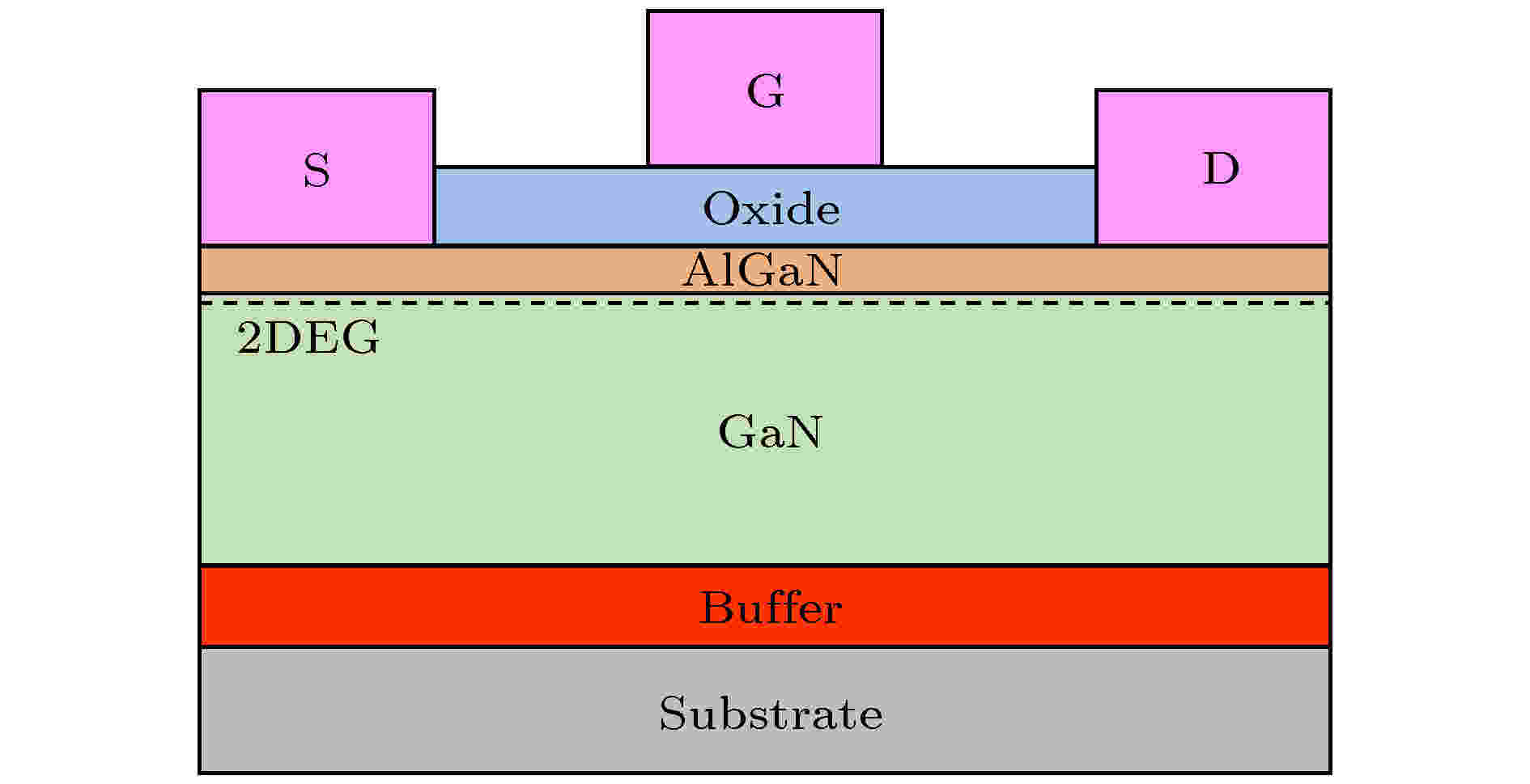
EDITOR'S SUGGESTION
2020, 69 (7): 078501.
doi: 10.7498/aps.69.20191557
Abstract +
In this paper, the total dose effect on AlGaN/GaN high-electron-mobility transistor (HEMT) devices after 60Co γ-ray irradiation with a total dose of 1 Mrad(Si) was investigated at different biases (VGS = –3 V, VDS
































